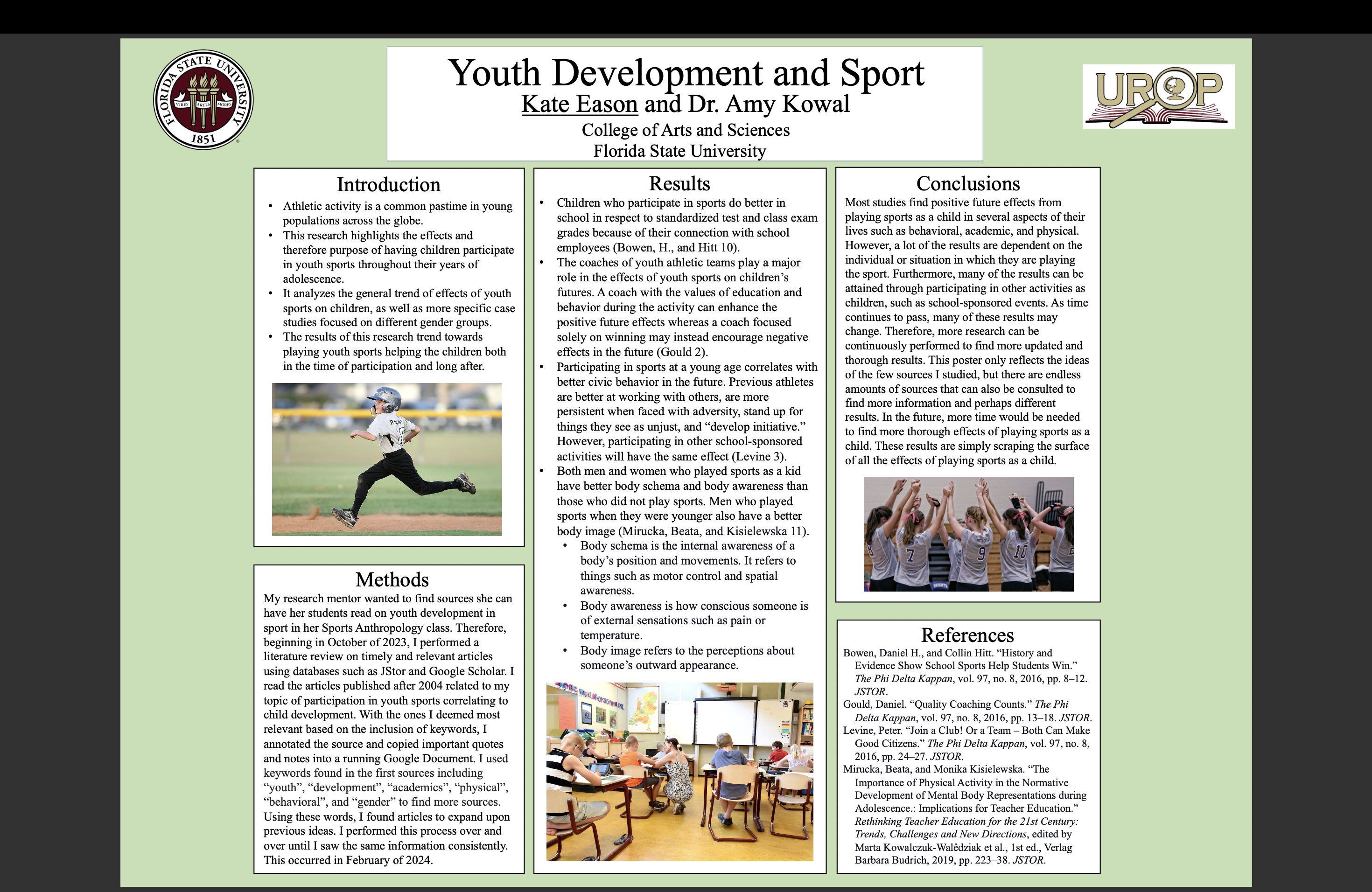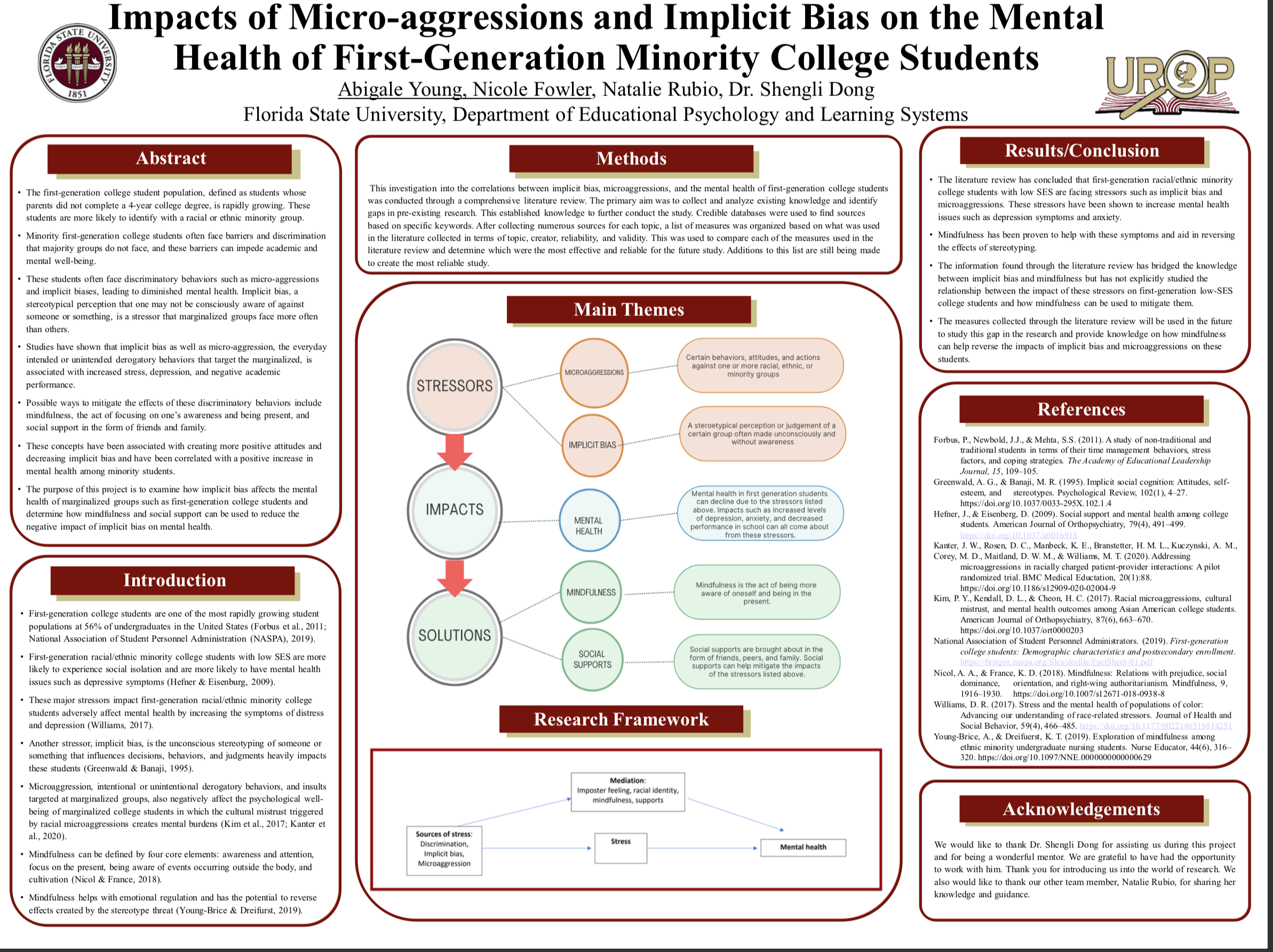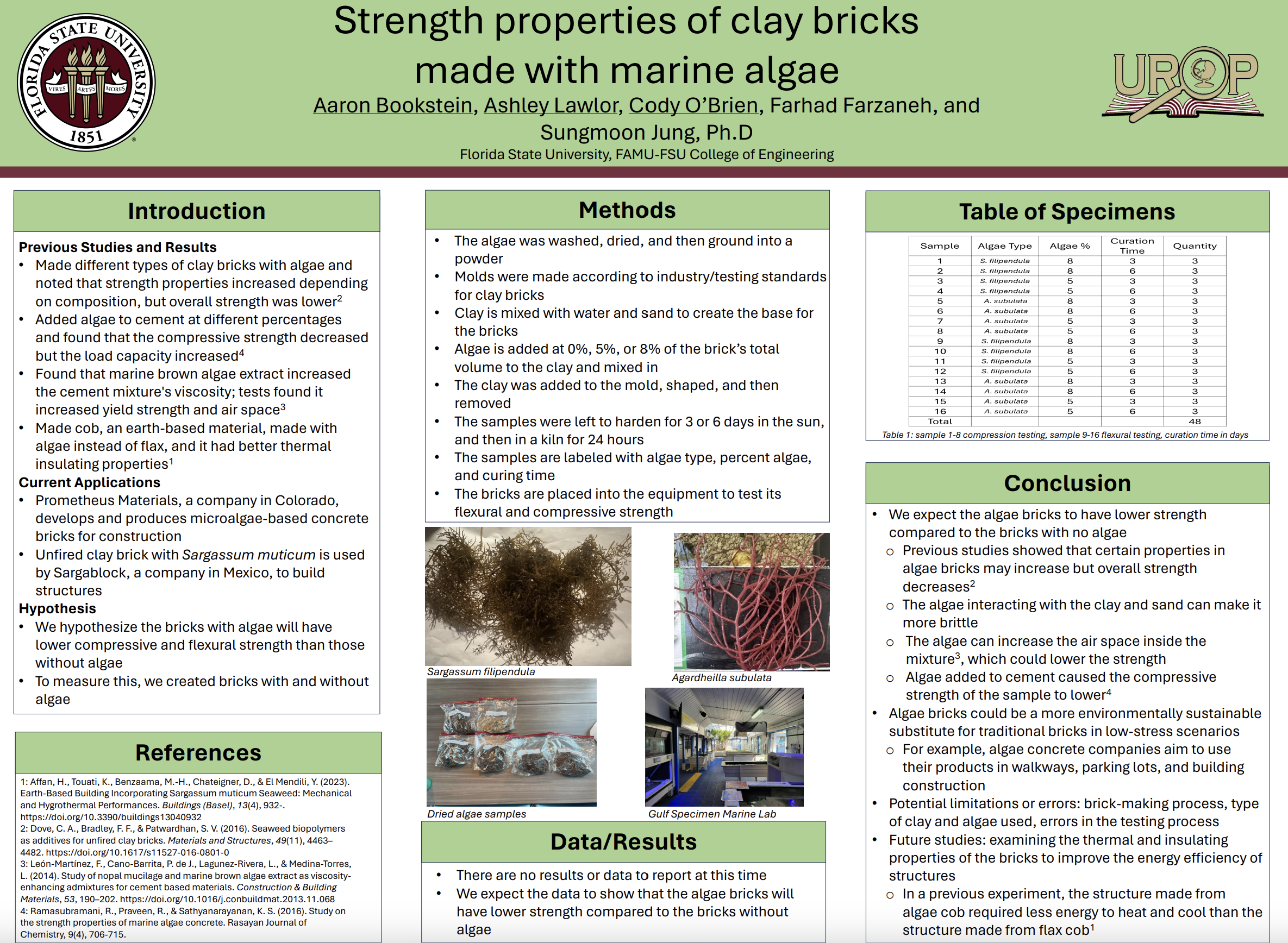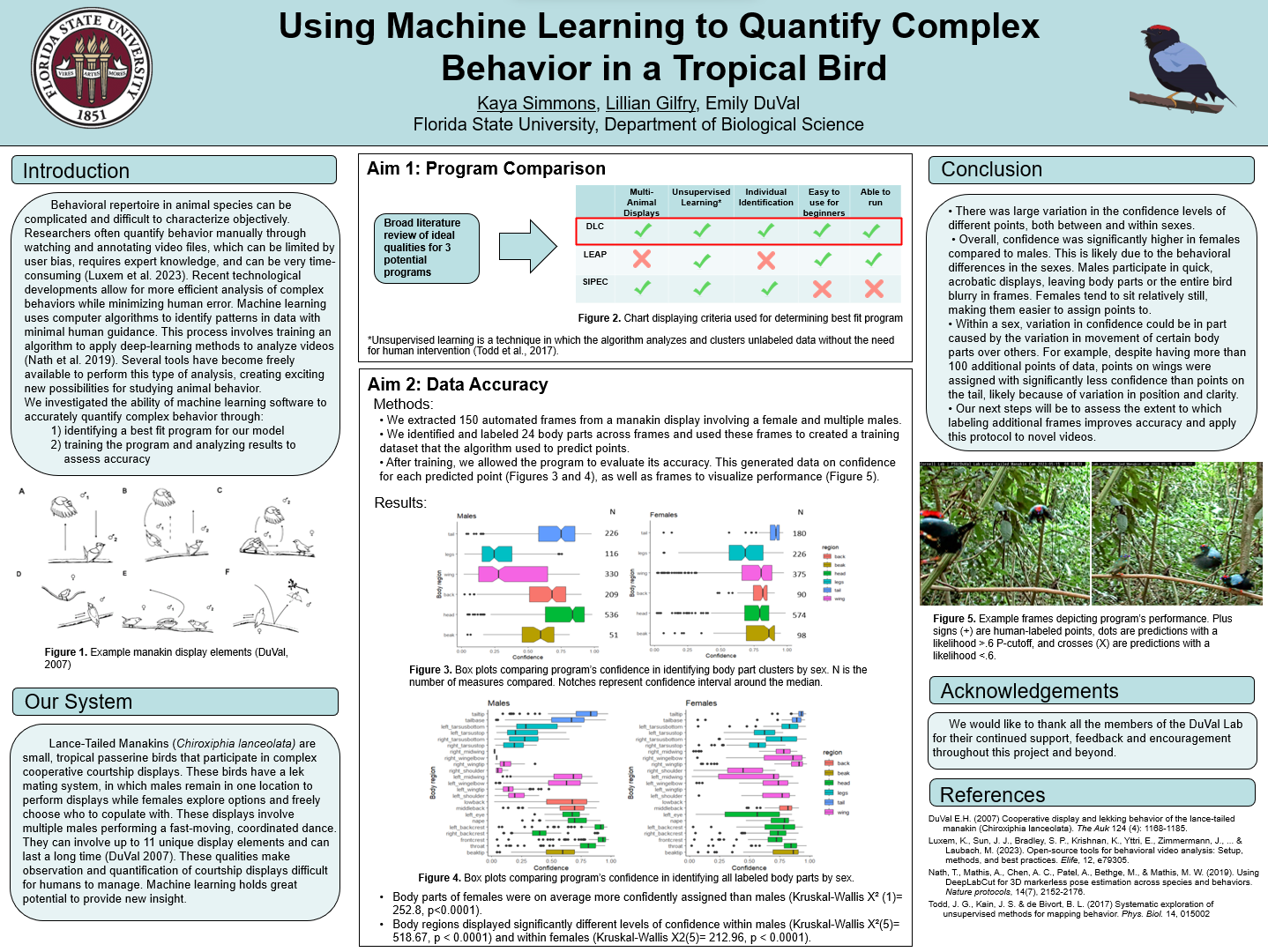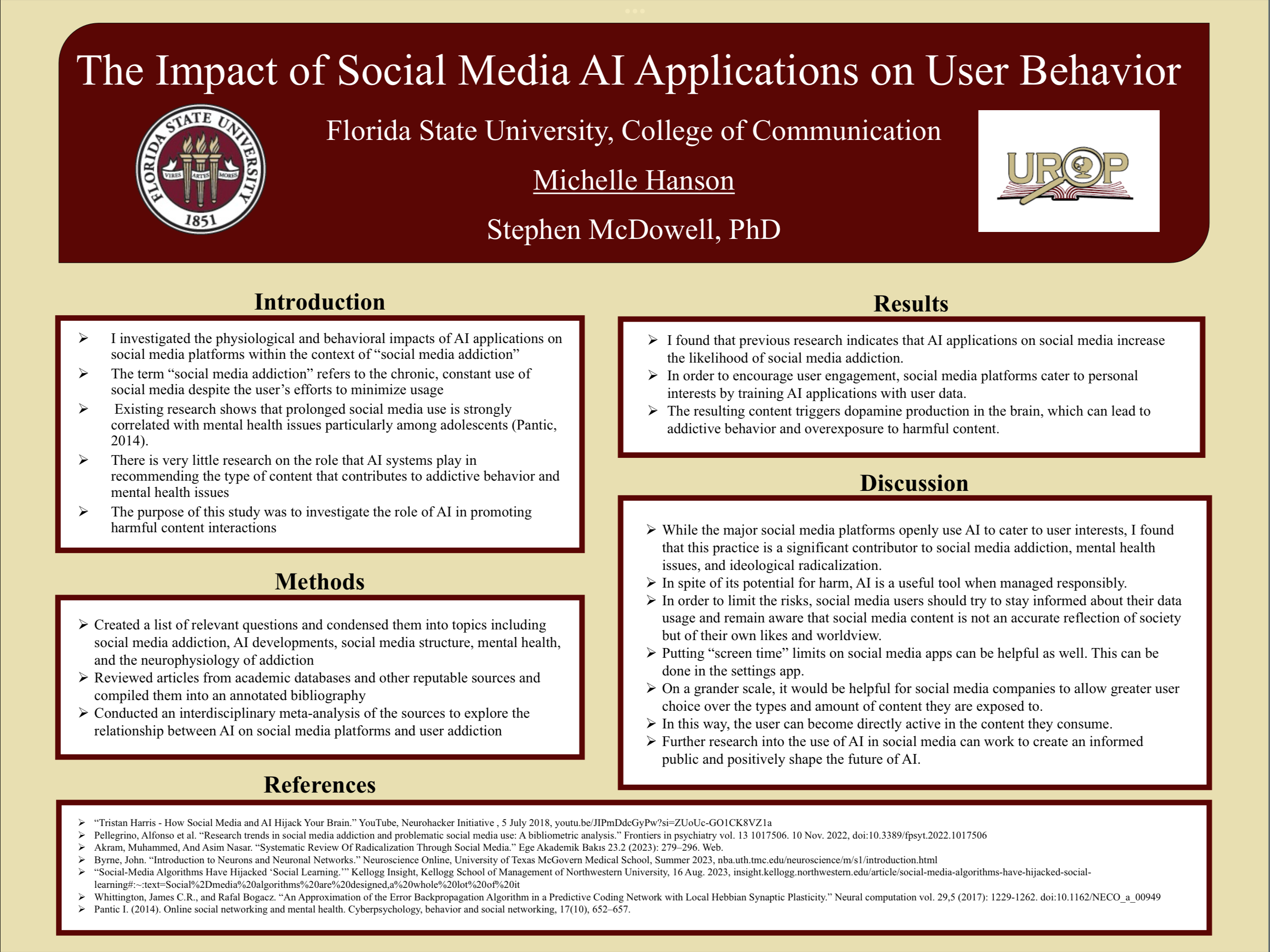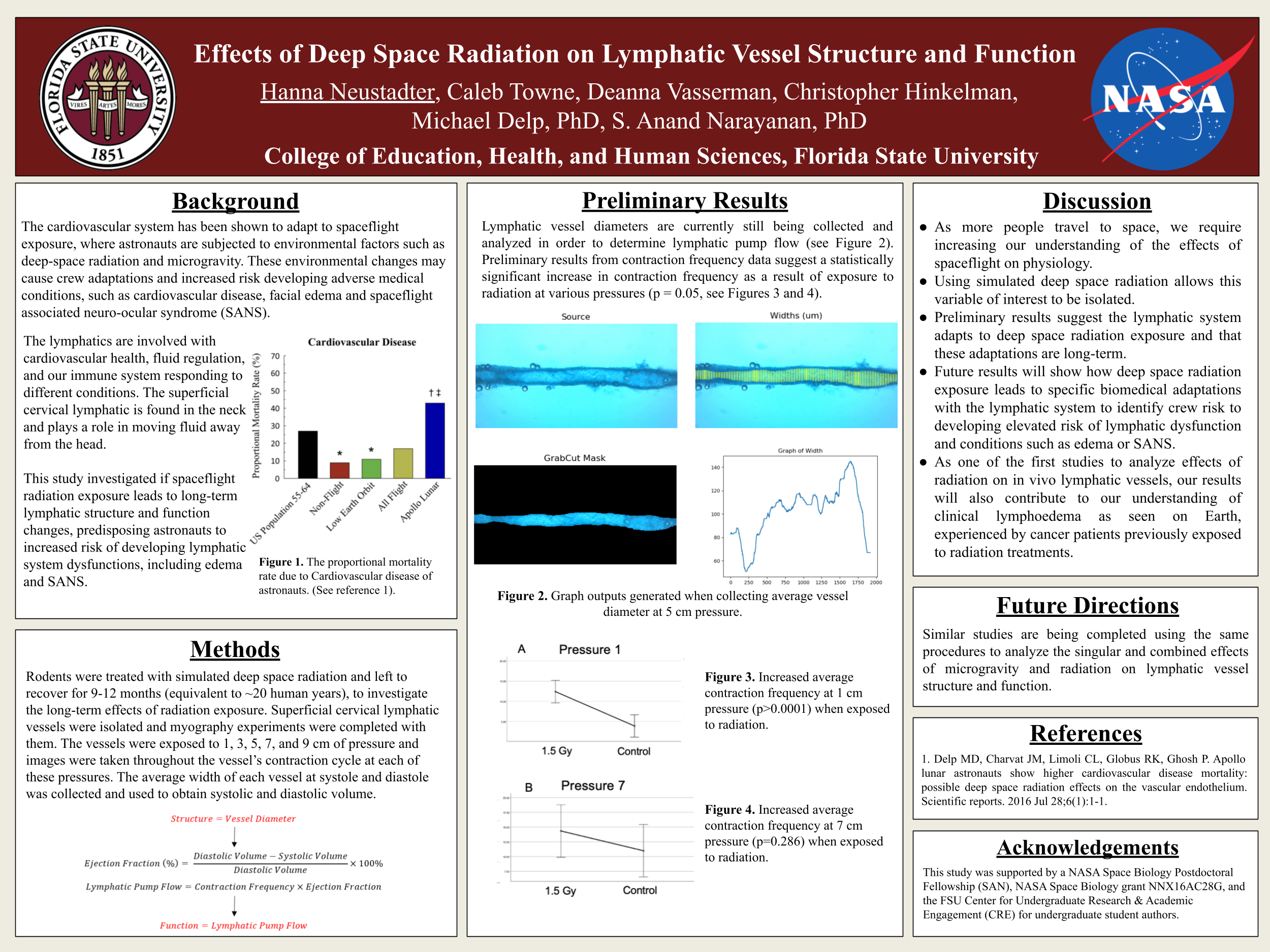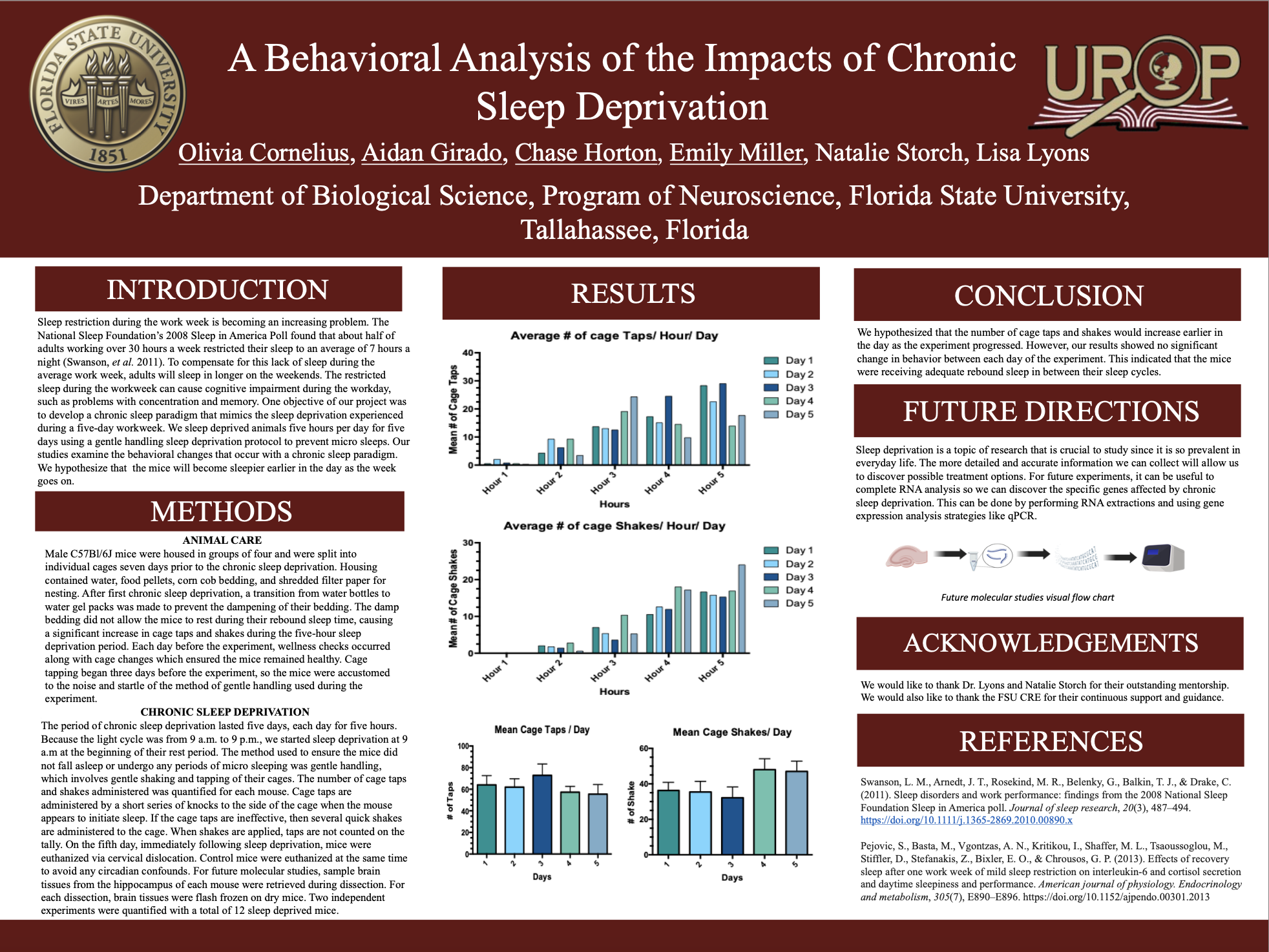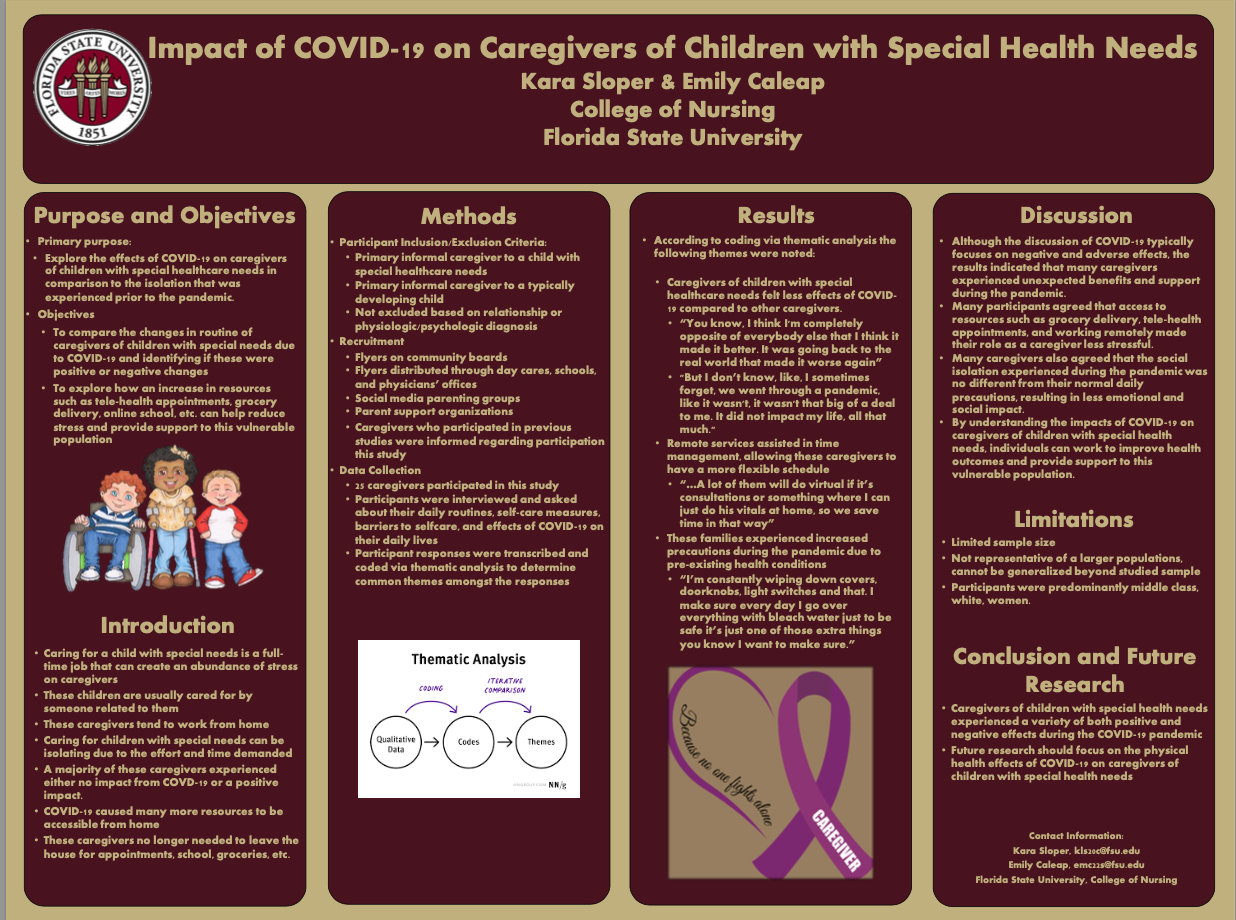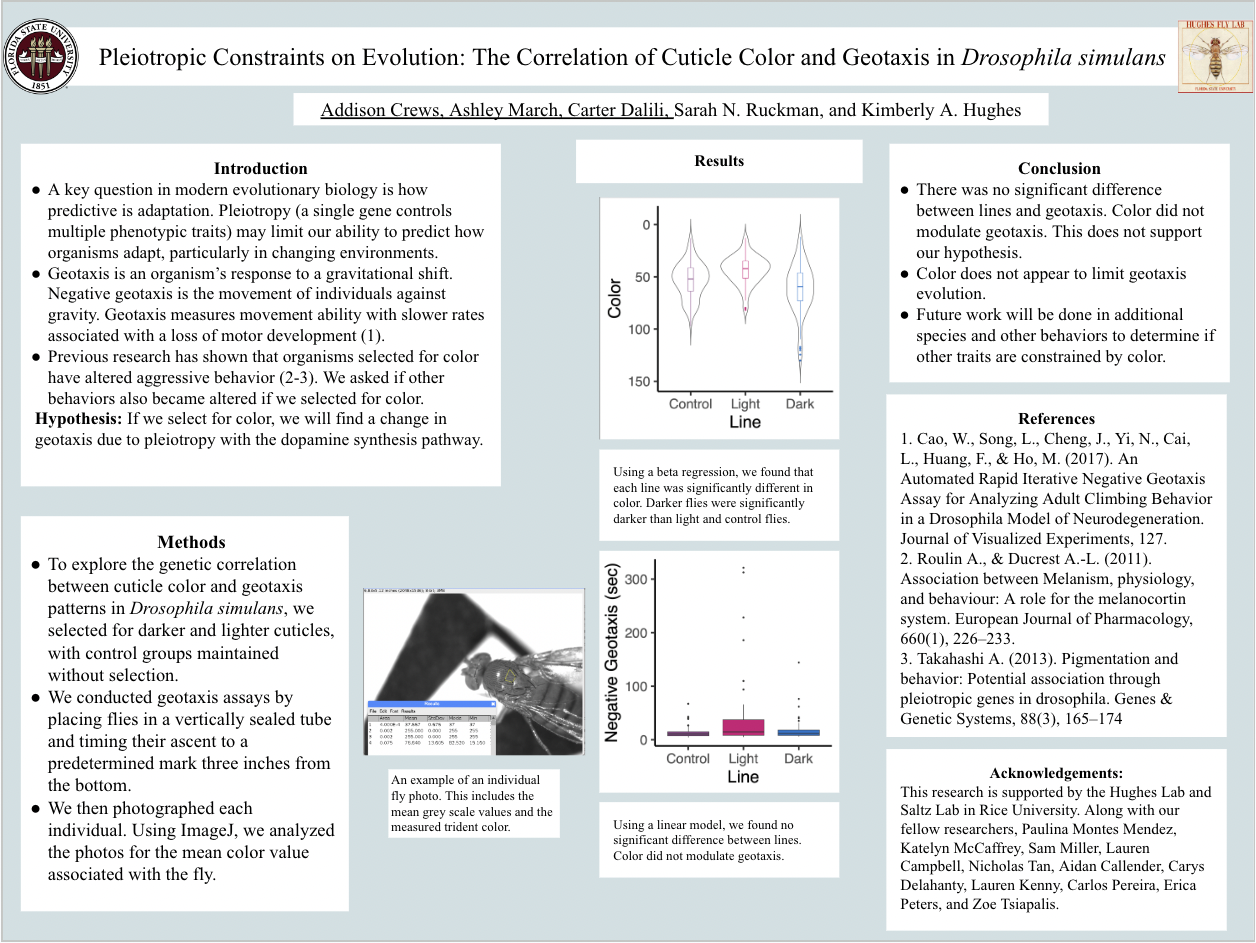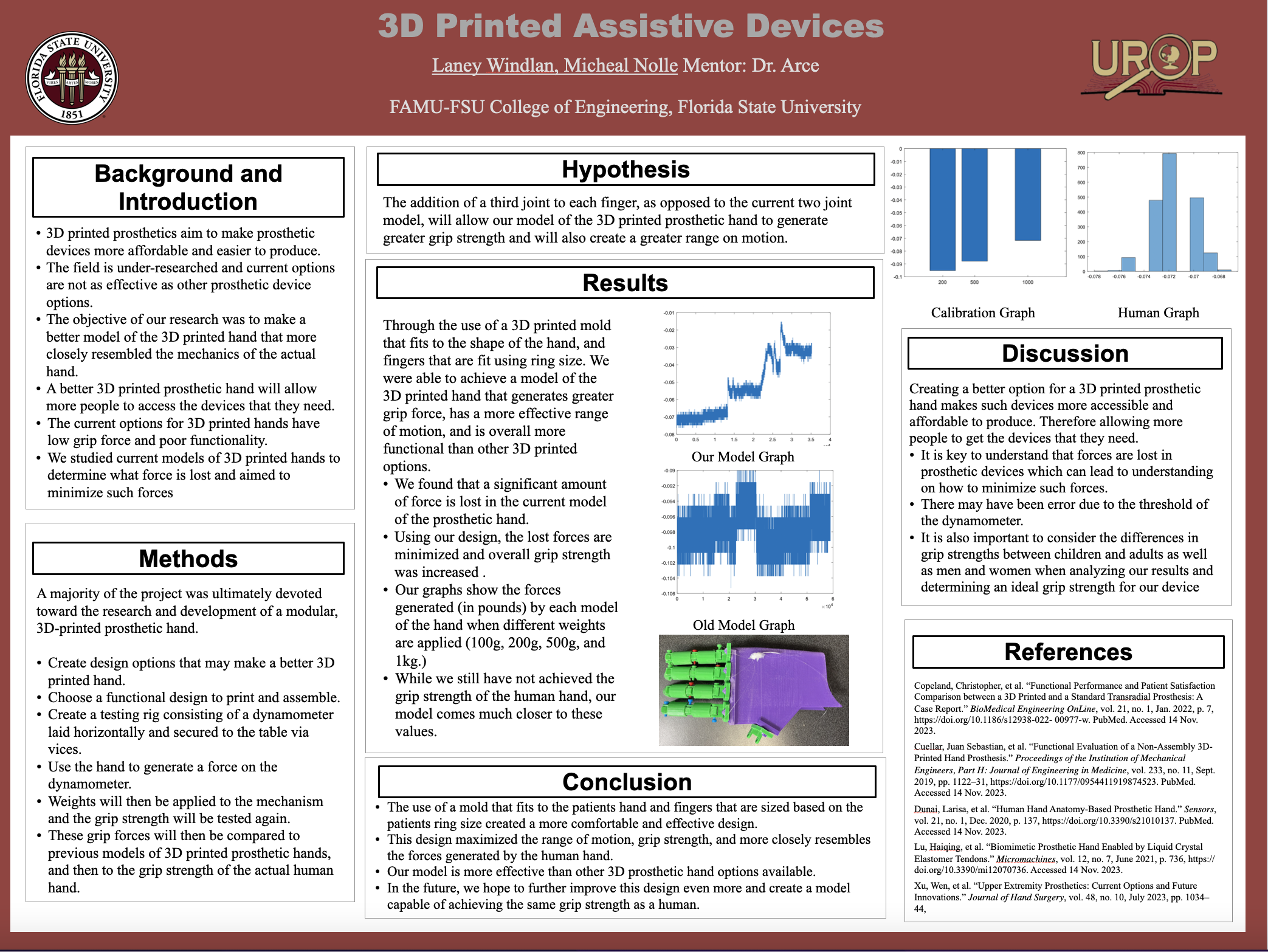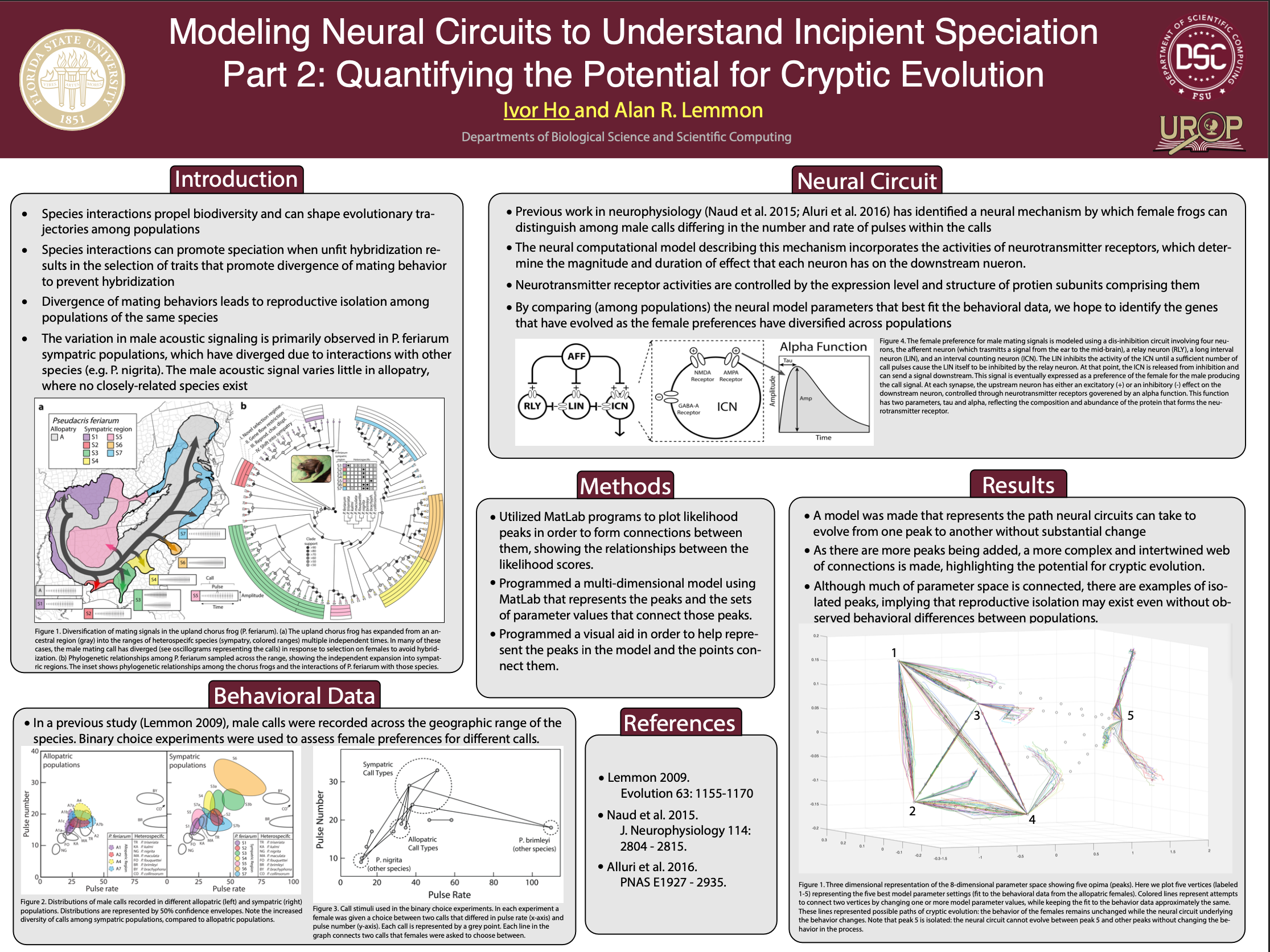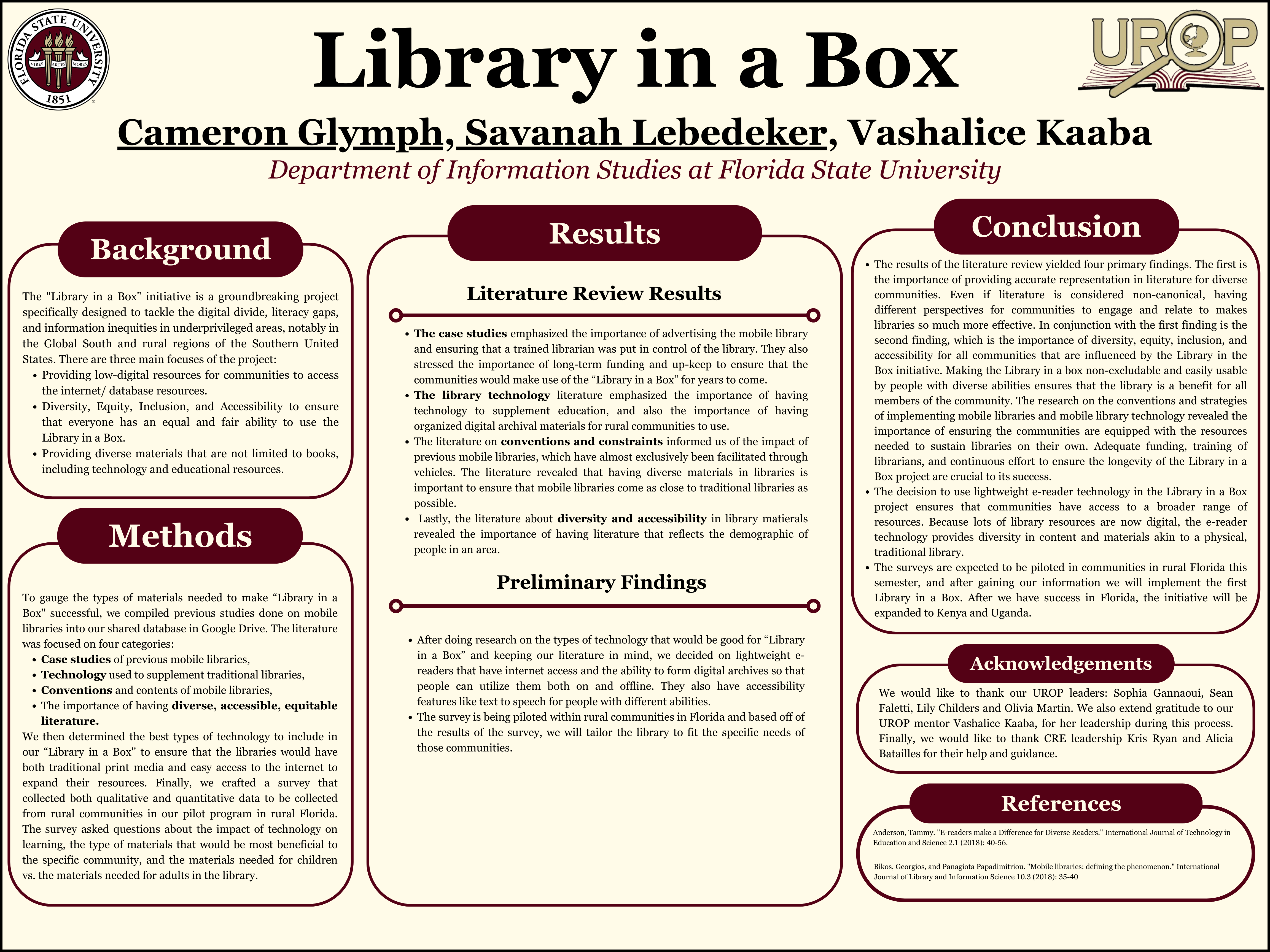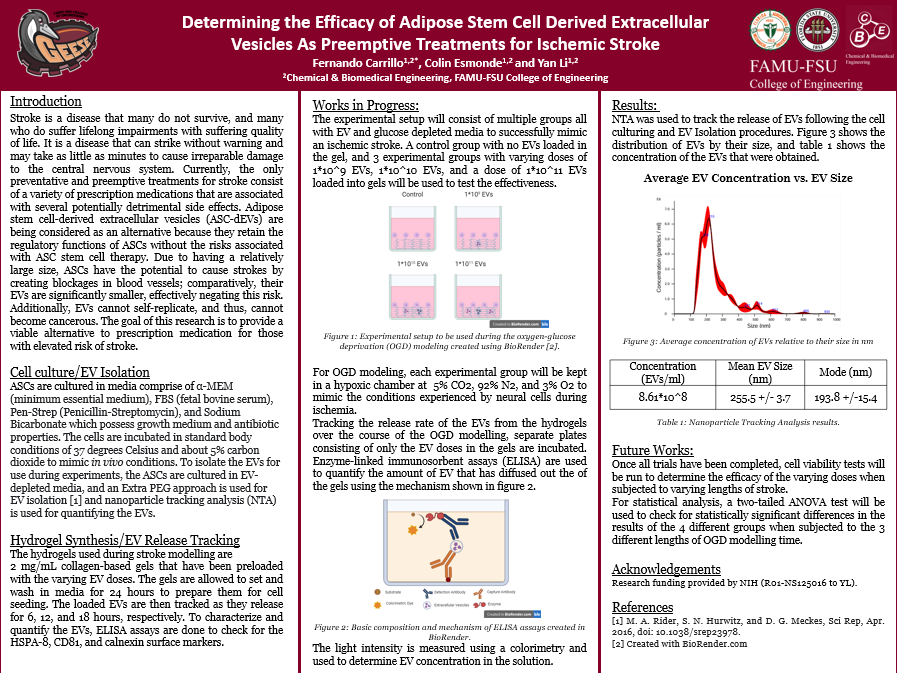Research Symposium
24th annual Undergraduate Research Symposium, April 3, 2024
Kate Eason Poster Session 4: 2:45 pm - 3:45 pm /76

BIO
My name is Kate Eason, and I am a sophomore here at Florida State University. I came here from my hometown of Kansas City, Missouri to pursue my career goals of either becoming a sports journalist or a lawyer. Outside of my academics, I act as a member of my sorority's New Member team as the Big Relations Chair. I also held a position as a Captain on the Leadership & Legacy team for Dance Marathon this year. I love attending any and all FSU sporting events, taking walks around campus with friends, and learning new things in all of my classes. I look forward to furthering my academic and personal abilities throughout the rest of my time here!
Youth Development and Sport
Authors: Kate Eason, Dr. Amy KowalStudent Major: Economics and English: Editing, Writing, and Media
Mentor: Dr. Amy Kowal
Mentor's Department: Department of Anthropology Mentor's College: University of Buffalo Co-Presenters:
Abstract
Children across the world participate in youth sports every day. As they play these sports throughout important developmental years, their experiences affect their character in the future. It has been found that competing in both club and school sponsored sports greatly affect the lives of these children, even in their adult years. This research uses several peer-reviewed sources to identify and define the differences in adults who played sports and those who didn’t. Although some sources found that playing sports as a child can have very little effect or even negative effects on the child’s future, the far majority highlight the benefits of competing in youth sports. Playing sports as a child leads to physical, academic, and character improvement in the future. Children participating in sports view their bodies in a more positive light, perform better on standardized testing and class materials, get in less behavioral trouble, participate more in civic responsibilities, and learn to commit and work for their goals both inside and outside of sports. This is important to understanding the effects of children playing sports and therefore the importance of youth participation in sports in the future.
Keywords: youth, sports, development
24th annual Undergraduate Research Symposium, April 3, 2024
Abigale Young Poster Session 3: 1:30 pm - 2:30 pm /45
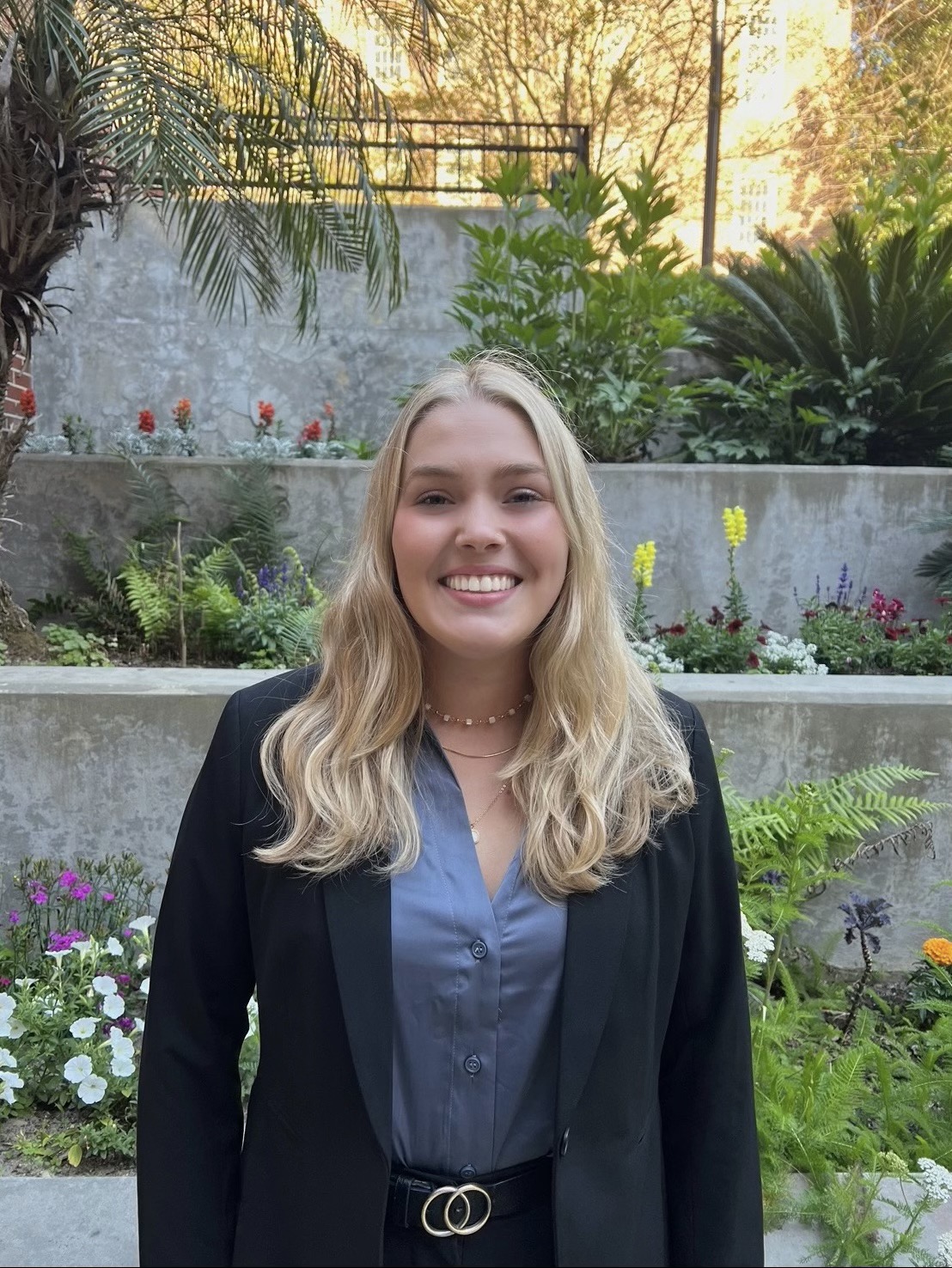
BIO
Hello! My name is Abigale Young. I am a Sophomore studying behavioral neuroscience on the pre-med track. I hope to attend medical school after completing my degree and specialize in psychiatry or neurology. I am from Ponte Vedra Beach, FL and absolutely love to learn. Whether that be a new subject in school, or one of the many hobbies I tend to pick up, I have always had a passion for knowledge. Some of my current hobbies include playing the guitar, painting, and reading. Perhaps it’s this tendency of mine that has made me truly enjoy my time in UROP. I have had the wonderful opportunity to participate in research in Dr. Shengli Dong’s lab and have gained essential skills and experience. I hope to continue participating in undergraduate research for the remainder of my time here at FSU. I cannot be more grateful for the terrific introduction into the world of research that I have gained over this past school year.
Impacts of Micro-aggressions and Implicit Bias on the Mental Health of First Generation Minority College Students
Authors: Abigale Young, Shengli DongStudent Major: Behavioral Neuroscience
Mentor: Shengli Dong
Mentor's Department: Department of Educational Psychology and Learning Systems Mentor's College: College of Education, Health, and Human Sciences Co-Presenters: Nicole Fowler
Abstract
The first-generation college student population, defined as students whose parents did not complete a 4-year college degree, is rapidly growing. These students are more likely to identify with a racial or ethnic minority group. Minority first generation college students often face barriers and discrimination that majority groups do not face, and these barriers can impede on academic and mental wellbeing. These students often face discriminatory behaviors such as micro-aggressions and implicit biases, leading to diminished mental health. Implicit bias, a stereotypical perception that one may not be consciously aware of against someone or something, is a stressor that marginalized groups face more often than others. Studies have shown that implicit bias as well as micro-aggression, the everyday intended or unintended derogatory behaviors that target marginalized groups including the target population of the current, is associated with increased stress, depression, and negative academic performance. Possible ways to mitigate the effects of these discriminatory behaviors include mindfulness, the act of focusing on one’s awareness and being present, and social support in the form of friends and family. These concepts have been associated with creating more positive attitudes and decreasing implicit bias and have been correlated with a positive increase in mental health among minority students. The purpose of this project is to examine how implicit bias affects the mental health of marginalized groups such as first-generation college students, and determine how mindfulness and social supports can be used to reduce the negative impact of implicit bias on mental health.
Keywords: Mental Health, First-Generation, Implicit Bias, Micro-aggressions
24th annual Undergraduate Research Symposium, April 3, 2024
Cody O'Brien Poster Session 3: 1:30 pm - 2:30 pm/234
BIO
Hello, I am a second-year student at the FAMU-FSU College of Engineering from Jacksonville, Florida. I chose this project since I was interested in creating stronger and more sustainable building materials, and I saw this algae-enhanced brick project as an intersection between my love for the natural world and the built world. This summer, I will complete an IDEA Grant fellowship on using algae to enhance permeable concrete. I hope to pursue a private, public, or academic career in the field of environmental engineering.
Strength properties of clay bricks made with marine algae
Authors: Cody O'Brien, Dr. Sungmoon JungStudent Major: Civil & Environmental Engineering
Mentor: Dr. Sungmoon Jung
Mentor's Department: Department of Civil & Environmental Engineering Mentor's College: FAMU-FSU College of Engineering Co-Presenters: Aaron Bookstein, Ashley Lawlor
Abstract
Acquiring sustainable and durable building materials is at the top of many developers’ agendas today. In the past several years, researchers have increasingly explored incorporating algae or algae-derived products into mediums like concrete and clay bricks, ideally in a carbon-neutral-or-negative context. This research ranges from incorporating whole algae to using certain extracts of algae (like cellulose nanofibers and alginate) to create or enhance these building materials. Scientists have seen generally positive results, likely thanks to the fibers in algae that help bind particles together. We will expand this knowledge through experiments on how two selected species of whole algae (Agardhiella subulata and Sargassum muticum) impact the flexural and compressive strength of clay bricks, depending on the concentration of the algae.
Keywords: sustainability, construction, algae, renewable, biology
24th annual Undergraduate Research Symposium, April 3, 2024
Kaya Simmons Poster Session 3: 1:30 pm - 2:30 pm /27
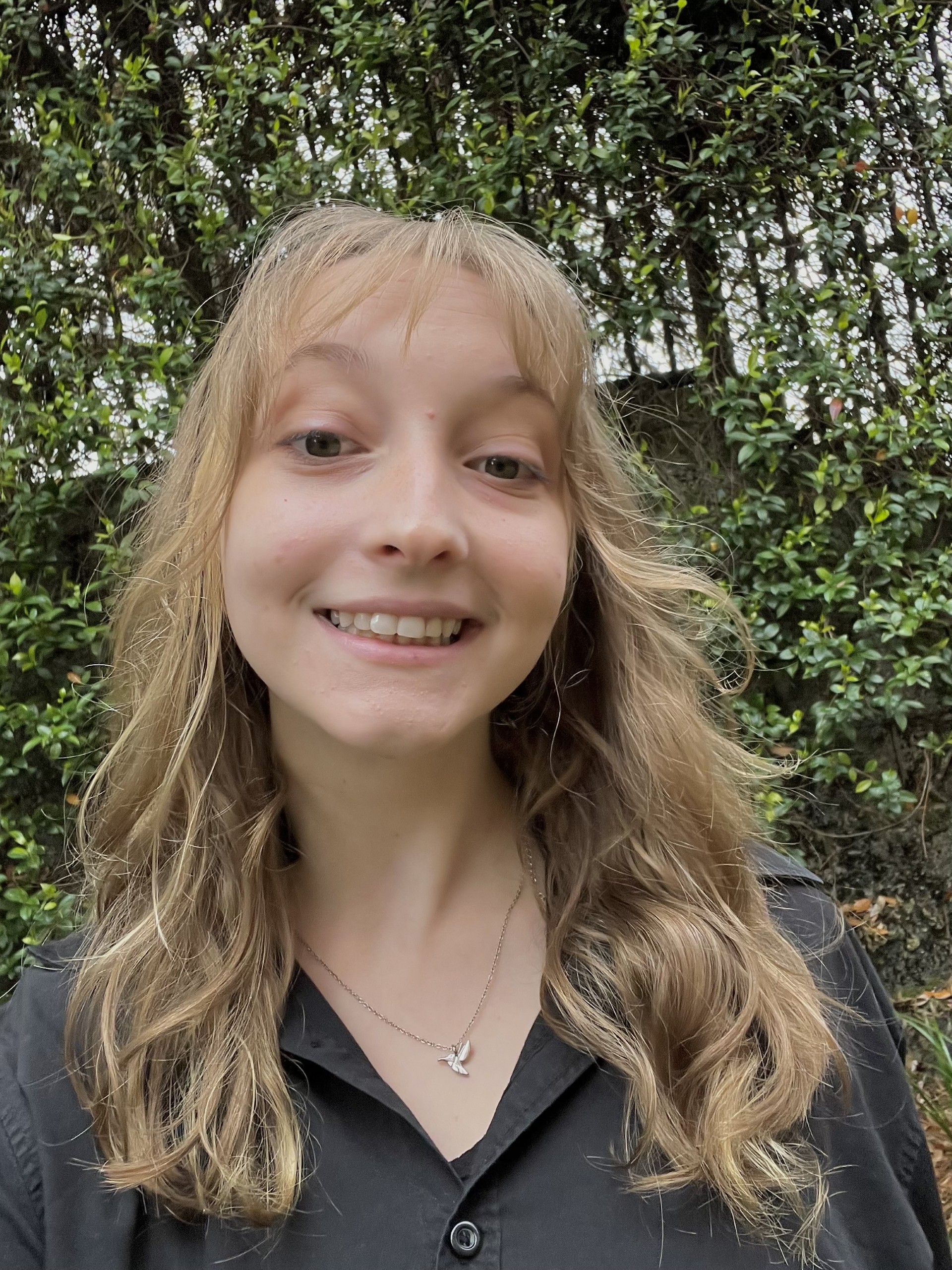
BIO
I am a second-year neuroscience major interested in non-human behavioral biology, ecology, and ornithology. I have been conducting research in the DuVal lab since my first semester at FSU, and plan to remain in this lab for the rest of my time as an undergraduate. I also conduct research in the Lemmon Lab, investigating the relationship between neuromodulators and social behavior in female Chorus frogs. Additionally, I am interested in conservation and hope to use the skills I've learned from this project to develop ways to apply machine learning to conservation efforts, such as detection and tracking of target species, or identifying and monitoring important behaviors. Once I graduate, I plan to complete a PhD and pursue research full-time.
Using Machine Learning to Quantify Complex Behavior in a Tropical Bird
Authors: Kaya Simmons, Emily DuValStudent Major: Behavioral Neuroscience
Mentor: Emily DuVal
Mentor's Department: Biological Sciences Mentor's College: Arts and Sciences Co-Presenters: Lillian Gilfry
Abstract
Complex interactions are difficult to analyze, but are a key part of animal behavior. Lance-tailed Manakins (Chiroxiphia lanceolata) participate in complicated multi-male courtship displays that can be difficult and incredibly time consuming to analyze manually. The complexity of these interactions makes it challenging to understand variation among competing groups, and details in patterns can be overlooked by the naked eye. However, the computational approaches of machine learning can be used to analyze and quantify these behaviors, offering a potential solution to these problems. Here we assess the ability of machine learning software to accurately quantify complex behavior. We first used a broad literature review to identify the best fit program for our model, then trained the program and analyzed results to assess accuracy. We chose DeepLabCut because of its capabilities for unsupervised, multi-animal identification and tracking. We then trained the program through extensive frame-labeling of displays and evaluated its accuracy in predicting body parts. Our results found that the confidence levels for identifying different body parts varied greatly within and across sexes. Within males, there was low confidence for identifying points on the wings and legs, and greatest confidence for points on the head. Females had greater confidence overall, with the tail being the greatest and legs being the weakest. Following this initial test, we plan to return to labeling to generate more data to increase the accuracy of the program so it can be used to better interpret this complex behavioral repertoire.
Keywords: Machine learning, ornithology, animal behavior
24th annual Undergraduate Research Symposium, April 3, 2024
Michelle Hanson Poster Session 3: 1:30 pm - 2:30 pm /333
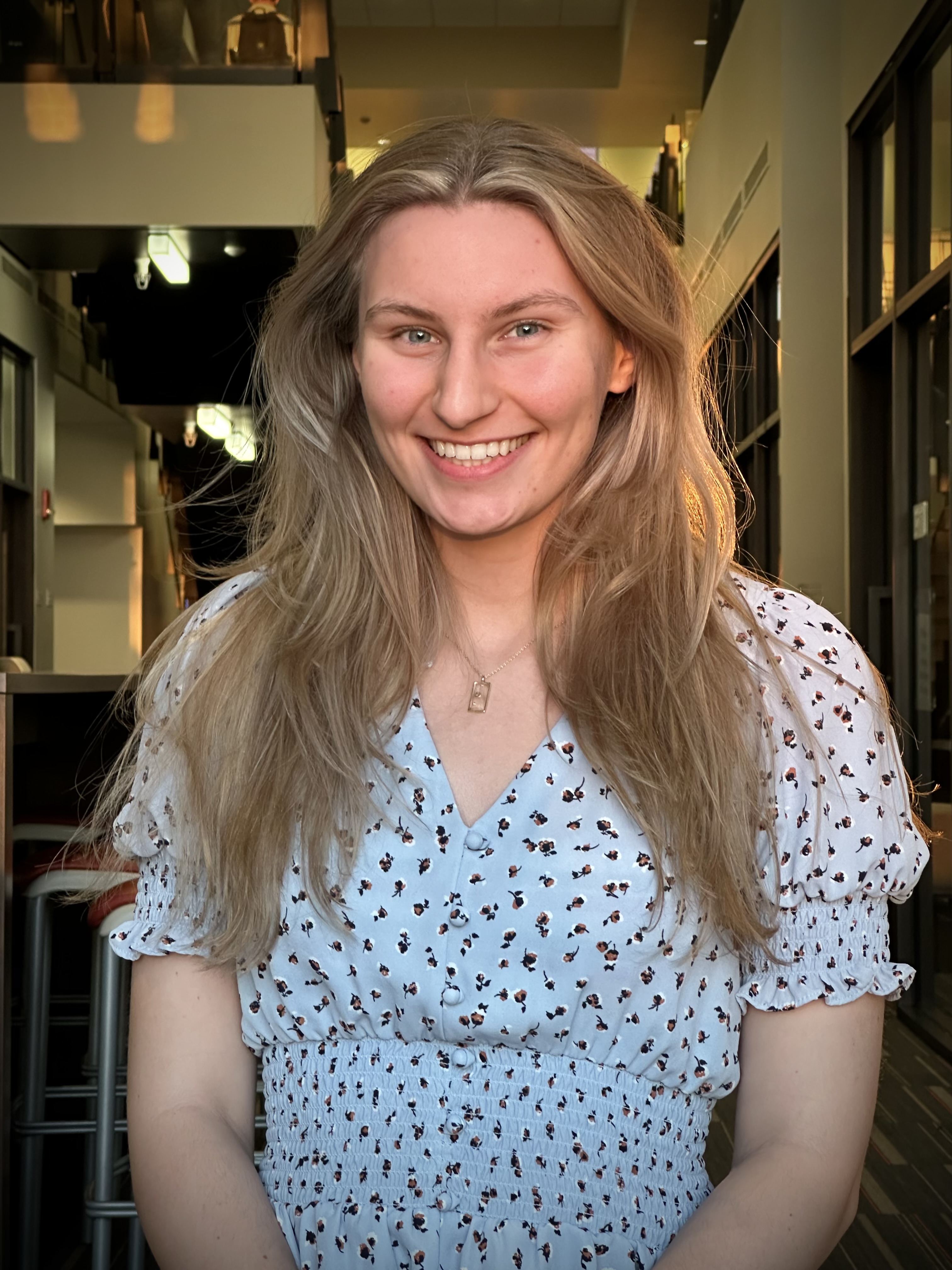
BIO
Michelle is a second-year behavioral neuroscience student with minors in chemistry and music. She has numerous academic interests within the field of neuroscience and beyond including neurophysiology, holistic medicine, Eastern spiritual practices, artificial intelligence (AI), and transcranial magnetic stimulation therapy (TMS). She is passionate about mental health and aspires to become a researcher in order to find new, effective approaches to help those with mental health issues. After graduation, she plans to travel abroad to study Eastern medicine, which she intends to incorporate into her research. Ultimately, she hopes to be able to offer streamlined, individualized mental health care to patients by bridging the gap between research findings and treatment plans. Since she is equally interested in conducting research and providing treatment, she is exploring M.D. and Ph.D. programs that would allow her to achieve both of these career goals.
The Impact of Social Media AI Applications on User Behavior
Authors: Michelle Hanson, Stephen McDowellStudent Major: Behavioral Neuroscience
Mentor: Stephen McDowell
Mentor's Department: International Initiatives Mentor's College: College of Communication and Information Co-Presenters:
Abstract
Over the past decade, the incorporation of artificial intelligence into various computer applications has skyrocketed. As a result, AI usage is now an integral part of everyday life, and it has come to change the way humans interact with technology. This study investigates AI systems on social media platforms and the impacts that such systems have on both the brain and human behavior. Previous studies have tied mental health issues to social media usage, but there is a lack of research investigating specifically how AI systems on these platforms impact user behavior. In order to explore such impacts, I conducted an interdisciplinary meta-analysis by reviewing sources on topics including mental health, developments in AI, social media structure, and the neurophysiology of addiction. While the major social media platforms openly use AI to cater to user interests, I found that this practice is a significant contributor to social media addiction, mental health issues, and ideological radicalization. In spite of its potential for harm, AI is a useful tool when managed responsibly. Further research into the use of AI in social media can work to create an informed public and positively shape the future of AI.
Keywords: Artificial Intelligence, Social Media, AI, Addiction, Psychology
24th annual Undergraduate Research Symposium, April 3, 2024
Hanna Neustadter Poster Session 4: 2:45 pm - 3:45 pm /450

BIO
As a senior from Tallahassee, Florida, I will be graduating in May 2024. I am in the Honors Program and the Honors in the Major Program, with this project being the focus of my undergraduate thesis. I am majoring in Health Management, Policy, and Information in the College of Medicine's Interdisciplinary Medical Sciences Program. I have also earned an undergraduate certificate in Health Information Technology. Beyond academics, I have served on the executive board of the Phi Delta Epsilon Medical Fraternity, as a Colloquium Leader for the Undergraduate Research Opportunity Program (UROP), and as a Learning Assistant for Biology 1. I have also conducted health information technology research for the State of Florida's Agency for Health Care Administration and currently work as a medical assistant at Dermatology Associates of Tallahassee. My passions lie in exploring interdisciplinary approaches to medical issues, particularly in space medicine and life sciences, and advocating for the transformative role of technology in healthcare.
Effects of Deep Space Radiation on Lymphatic Vessel Structure and Function
Authors: Hanna Neustadter, Dr. Anand NarayananStudent Major: Health Management, Policy, and Information
Mentor: Dr. Anand Narayanan
Mentor's Department: Department of Nutrition & Integrative Physiology Mentor's College: College of Education, Health, and Human Sciences Co-Presenters:
Abstract
When people travel into space, they are exposed to the unique spaceflight environment, which includes experiencing weightlessness (e.g. microgravity) and space radiation. Physiological adaptations occur when exposed to these different environmental stimuli; one example being the alteration of lymphatic function. The lymphatics are involved with cardiovascular health, fluid regulation, and our immune system responding to different conditions. We have observed suggestions of astronauts experiencing changes in their lymphatic biology, based on symptoms they experience including swelling in the head, vision loss, etc. This study is specifically focused on examining the long-term effects of space radiation on lymphatic biology. We have completed experiments investigating the physiology and biochemistry of lymphatic vessels in response to being treated with simulated deep space radiation and then allowed to recover, simulating a trip of astronauts to the Moon and back and measuring their health later in their lives. Our preliminary findings suggest novel adaptations and responses of the lymphatics to space radiation. The results from this study will increase our overall knowledge in the field of space medicine as well as improve life on Earth by expanding our understanding of the lymphatic system and how biology responds to certain forms of radiation.
Keywords: space, lymphatics, medicine, cardiovascular, radiation
24th annual Undergraduate Research Symposium, April 3, 2024
Aidan Girado Poster Session 5: 4:00 pm - 5:00 pm/150

BIO
My name is Aidan Girado, I am a sophomore undergraduate student at Florida State University studying Biological Sciences, with a minor in Chemistry. I assist in research projects, volunteer at Tallahassee's local hospital, and work as a medical transporter at Baptist Hospital. I aim to apply for medical school and gain as much clinical/research experience in order to be a strong candidate.
A Behavioral Analysis of the Impacts of Chronic Sleep Deprivation
Authors: Aidan Girado, Lisa LyonsStudent Major: Biological Sciences
Mentor: Lisa Lyons
Mentor's Department: Biological Science Faculty Member Mentor's College: College of Arts and Sciences Co-Presenters: Olivia Cornelius, Chase Horton, Emily Miller
Abstract
Sleep deprivation is a global health issue that is especially prevalent during the work week. A significant amount of the working population restricts their sleep to seven hours or less a night during the work week. This sleep restriction has been linked to cognitive impairment during the workday, leading to issues related to memory and performance. We have developed a chronic sleep paradigm to mimic the sleep deprivation experienced during the 5-day work week. We hypothesize that the mice will progressively get sleepier earlier in the day as the week goes on. For this experiment, mice were split into individual cages containing water, food pellets, and shredded filter paper bedding. Transition from water bottles to water gel packs occurred after one of the preliminary chronic sleep deprivations to avoid wetting the cage bedding. Each chronic sleep deprivation experiment lasted five days for 5 hours a day with two independent experiments performed. The method used to prevent sleeping was gentle handling through cage taps and cage shakes. After the experiment, brain tissues were collected from each mouse in order to perform future molecular studies. We found that the mean cage taps and shakes did not show any significant difference throughout the experiments. The results indicate that the mice were getting sufficient rebound sleep in between the days of sleep deprivation. Further directions include performing a molecular analysis of changes in gene expression using qPCR.
Keywords: sleep deprivation, mice, behavioral analysis
24th annual Undergraduate Research Symposium, April 3, 2024
Nailah Lee Poster Session 3: 1:30 pm - 2:30 pm /39

BIO
Greetings! I am a second-year undergraduate student at Florida State University, hailing from Jacksonville, Florida. Currently, I am pursuing a major in dance alongside a pre-med track. My academic curiosity centers around researching the multifaceted social and physical benefits inherent in dance. Beyond academia, I find joy in exploring various destinations, immersing myself in literature, and relishing the beauty of a sunset.
#CapeBreak: The Reverse Engineering of the Strong Black Women Phenomena
Authors: Nailah Lee, Dr. Chris OmniStudent Major: Dance
Mentor: Dr. Chris Omni
Mentor's Department: Art Education Mentor's College: Fine Arts Co-Presenters: Christina Dugazon
Abstract
The #CapeBreak Project offers a diverse perspective from four resilient Black women between the ages of 34 and 58. The initiative seeks to challenge the stereotype of being the “Strong Black Woman” who is burdened with the expectation to be mentally and physically strong for everyone around them. Through art-based research, we explored intergenerational dynamics, the psychological influence of nature, and the emotional well-being of Black women. To support our research we completed literature reviews of our main themes and analyzed the interviews of the four black women, striving to find commonalities between the participants.
The #CapeBreak study will conclude with a live ethnographic performance, conference/ festival presentations, panel discussions, and journal publications. We aim to reach a broader audience by highlighting the importance of Black joy globally and supporting Black women who feel constrained by being the “Strong Black Woman."
Keywords: strong, black, rest, nature, women
24th annual Undergraduate Research Symposium, April 3, 2024
Kara Sloper Poster Session 2: 10:45 am - 11:45 am/442

BIO
Kara Sloper is a senior from Ellicott City, Maryland double majoring in nursing and public health. Her passion for research developed in high school, where she researched more effective cures for prostate cancer at The University of Maryland, Baltimore County. Kara completed the Undergraduate Research Opportunity Program (UROP) during her sophomore year where she conducted research under The Leadership Programs Project, and she has served as a UROP Leader during her junior and senior years. Outside of research, Kara is involved in The University Honors Program, Pi Beta Phi sorority, Engage 100, and she works as a pediatric medical assistant. Upon graduation, she hopes to begin her career as a pediatric critical care nurse. Kara would like to thank Dr. Bamber for allowing her to continue her passion for nursing research during her senior year!
Impact of COVID-19 on Caregivers of Children with Special Health Needs
Authors: Kara Sloper, Dr. Mandy BamberStudent Major: Nursing & Public Health
Mentor: Dr. Mandy Bamber
Mentor's Department: Nursing Mentor's College: College of Nursing Co-Presenters: Emily Caleap
Abstract
Caregivers of children with special health needs experience an abundance of stress throughout their everyday lives. Having an individual who is completely dependent on their caregiver can be greatly taxing due to the complexity and extent of care. The goal of this study was to determine the effects of COVID-19 on caregivers of children with special health needs. Twenty five caregivers were interviewed and asked about their daily routines, selfcare habits, and experiences with COVID-19. The interviews were then coded via thematic analysis to determine common themes among the participants. Although the discussion of COVID-19 typically focuses on negative and adverse effects, the results indicated that many caregivers experienced unexpected benefits and support during the pandemic. Many participants agreed that access to resources such as grocery delivery, tele-health appointments, and working remotely made their role as a caregiver less stressful. Less time was spent on route to doctor appointments, therapies, and education. Many caregivers also agreed that the social isolation experienced during the pandemic was no different from their normal daily precautions, resulting in less emotional and social impact. By understanding the impacts of COVID-19 on caregivers of children with special health needs, individuals can work to improve health outcomes and provide support to this vulnerable population.
Keywords: nursing, caregiver, special health needs, COVID-19
24th annual Undergraduate Research Symposium, April 3, 2024
Alyssa Yon Poster Session 3: 1:30 pm - 2:30 pm/252
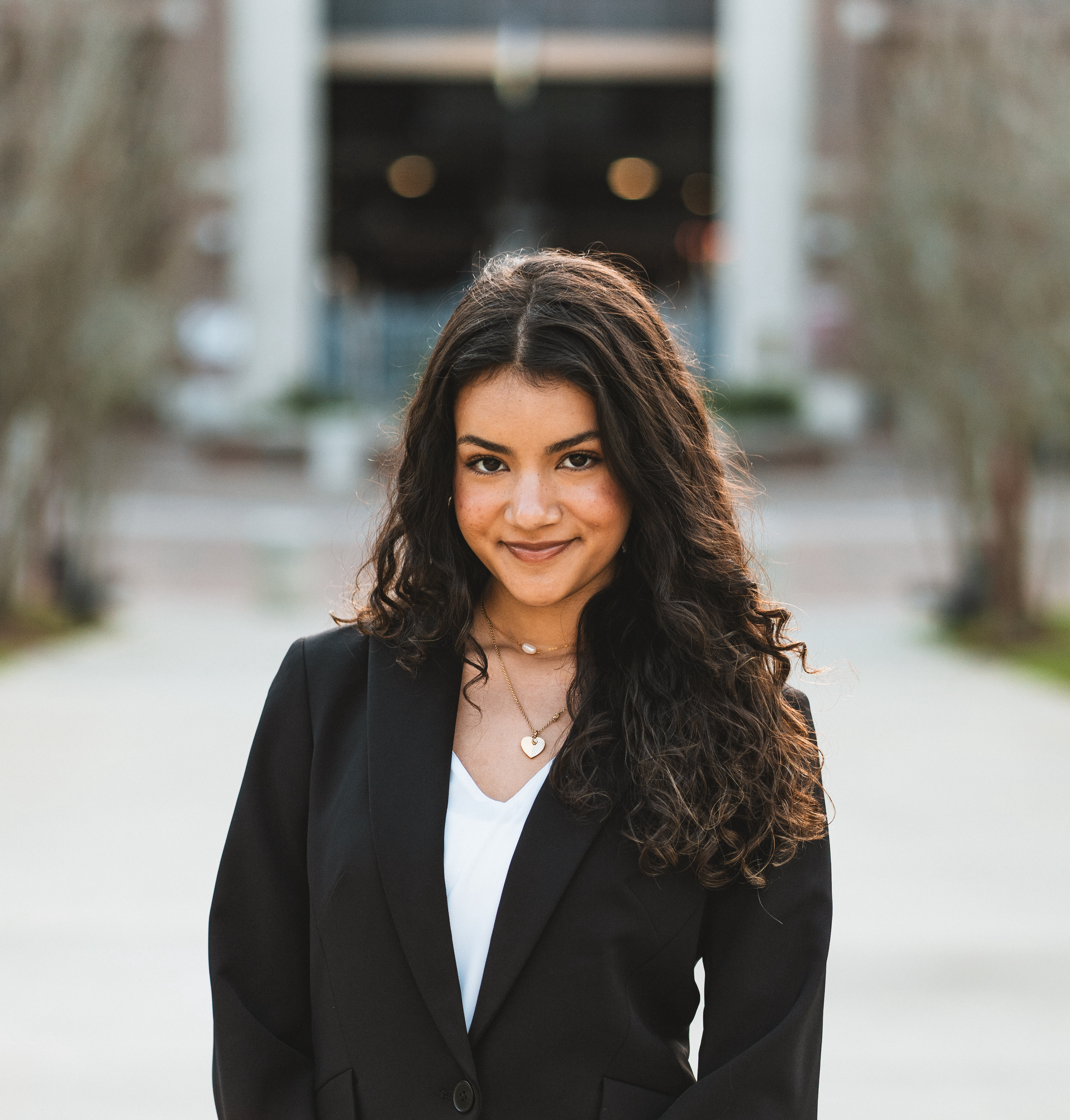
BIO
I'm a second-year student from Winter Park, Florida, and am particularly interested in research that addresses social and structural inequality. In the future, I hope to work in politics.
Graduate Students' Construction of Professional Selves
Authors: Alyssa Yon, Andre IveyStudent Major: English Literature/Media/Culture and Political Science
Mentor: Andre Ivey
Mentor's Department: Sociology Mentor's College: College of Social Sciences and Public Policy Co-Presenters: Lea Graham
Abstract
Society is evolving to break gender, racial, and sexual stereotypes, yet this does not dismiss the minorities who have lived their entire lives with these stereotypes being placed on them. Research has demonstrated that people from minorities have faced discrimination from the institutions that are meant to support our country such as schools and places of work. Schools have been flawed in shaping malleable students' mindsets on minorities from the elementary level to the college level. Previous research has neglected to take the nuances of intersectionality into account when conducting research. Our research team has conducted interviews with sociology graduate students to get their perspective on the discrimination towards themselves. We also look at how instructors have navigated conversations within the classroom to make them more conducive to recent political regulations. Gaining an in-depth look at these graduate students' perspectives has allowed us to understand how institutions push for information to be either concealed or exploited to benefit a certain political narrative. Given that the sample is made up of Florida residents, we also gain insight into the consequences of these learning restrictions and how they translate to a classroom setting.
Keywords: Education, Identity, Policy,
24th annual Undergraduate Research Symposium, April 3, 2024
Addison Crews Poster Session 3: 1:30 pm - 2:30 pm/318
BIO
Hello, my name is Addison Crews. I am originally from Nashville, Tennessee. I am a second year Biological Sciences student here at FSU. I currently plan on attending veterinary school after my undergraduate. I began working in the Hughes Lab in September 2022 and I've loved the experience. I have a piqued interest in field research within the realm of animal behavior and genetics.
Pleiotropic Constraints on Evolution: The Correlation of Cuticle Color and Geotaxis in Drosophila simulans
Authors: Addison Crews, Sarah RuckmanStudent Major: Biological Sciences
Mentor: Sarah Ruckman
Mentor's Department: Biology Mentor's College: College of Arts and Sciences Co-Presenters: Ashley March, Carter Dalili
Abstract
One long standing question in evolutionary biology is whether single genes that control multiple traits (pleiotropy) results in limitations on adaptive evolution. If it does, then our ability to predict adaptation (e.g., in the face of changing environments) is compromised. We are using a much-discussed correlation between body coloration and aggressive behavior as a system to address this question. Having found the predicted genetic correlation between cuticle color and aggressive behavior in Drosophila simulans using artificial selection (unpublished data), we then asked if any other behaviors co-evolved under selection on cuticle color. For example, the dopamine synthesis pathway is plausibly related to color, aggression, and other behaviors, such as geotaxis level. Negative geotaxis is the movement of individuals against gravity. This is a measure for general activity and motor development. Efficiency of geotaxis has been used to measure movement ability, with a slower rate of geotaxis associated with a loss of motor development and neurodegeneration. We therefore measured geotaxis ability of flies (D. simulans) selected for darker and lighter cuticle color. To measure geotaxis, flies are placed in a vertically sealed tube and timed for how quickly they climb to a predetermined mark at 3 inches from the bottom of the tube. Results suggest that time to climb to the top of the tube is faster in the dark-selected lines, suggesting that genetic correlations do constrain the independent evolution of cuticle color and behavior.
Keywords: Pleiotropy, Geotaxis, Color, Drosophila simulans
24th annual Undergraduate Research Symposium, April 3, 2024
Laney Windlan Poster Session 5: 4:00 pm - 5:00 pm/131
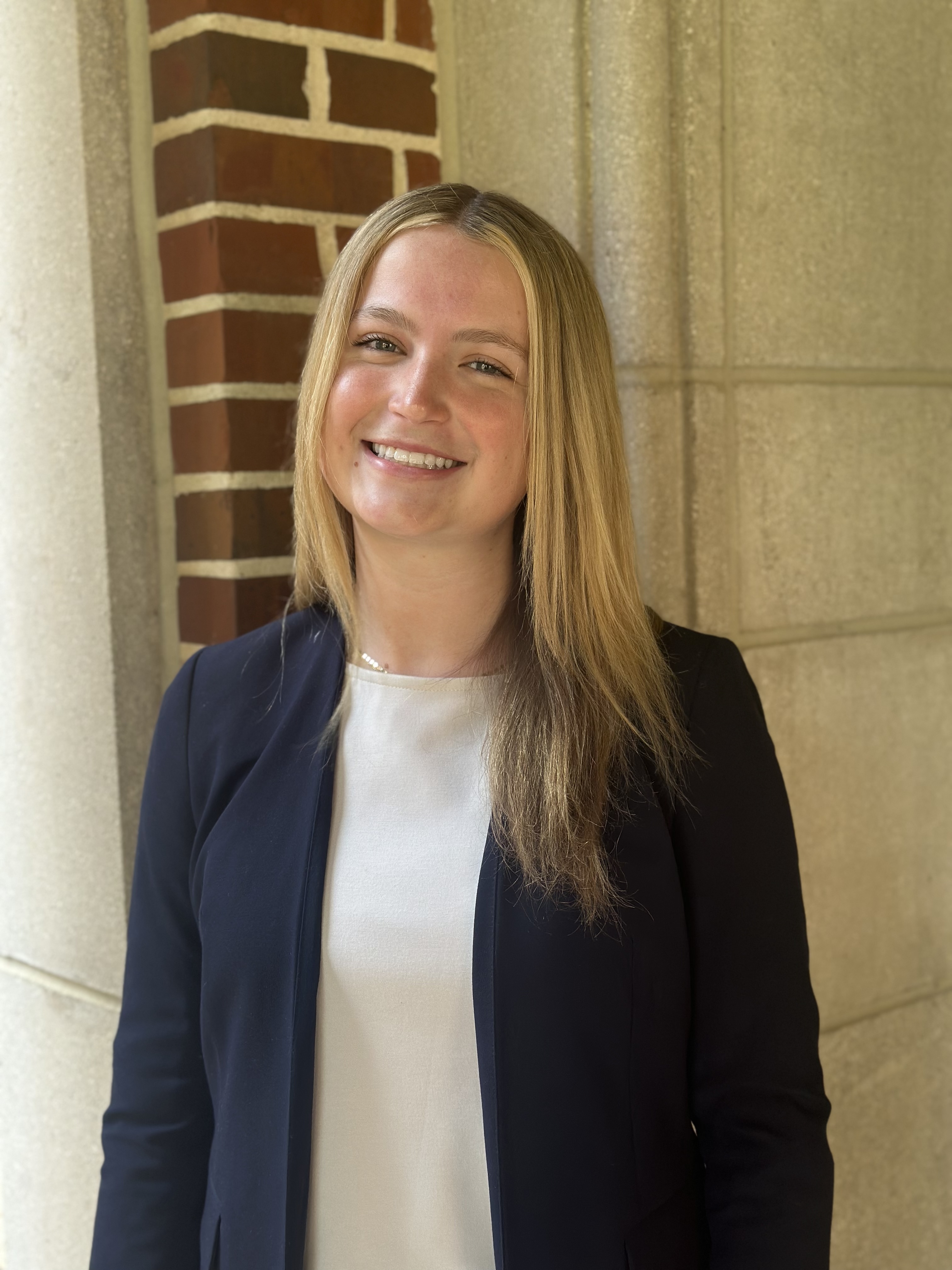
BIO
My name is Laney Windlan, I am a first year Civil Engineering Major at Florida State University, and I am from Hudson, Florida. My research project focused on the development of prosthetic devices which I am very Interested in and passionate about.
3D Printed Assistive Devices
Authors: Laney Windlan, Stephen Hugo ArceStudent Major: Civil Engineering
Mentor: Stephen Hugo Arce
Mentor's Department: Department of Biomedical Engineering Mentor's College: College if Engineering Co-Presenters: Micheal Nolle
Abstract
The majority of publicly available, 3D-printable prosthetic devices typically serve an exclusively aesthetic purpose; nearly all of them do not actually function, do not sufficiently fit, or otherwise fail to meet a person’s needs. The goal of this project is to develop a functional, customizable, and ideally fully 3D-printable prosthetic device to publish publicly and freely for the public to download and use at minimal cost and effort to assemble. By performing literature review on previously designed models for prosthetic hands and adapting the ideas in different ways through SOLIDWORKS, we are aiming to design a suitable device to reach as large of an audience as possible that is comfortable, aesthetically pleasing, and functional, with minimal effort to assemble. The functionality of the device will be measured by using a dynamometer to assess grip force, and then compare this to the grip force required for everyday tasks.
Keywords: Prosthetics, Engineering, Biology
24th annual Undergraduate Research Symposium, April 3, 2024
Ivor Ho Poster Session 3: 1:30 pm - 2:30 pm /423
BIO
I am a first year undergraduate originally from Texas and I want to pursue a career of medical research. Particularly, I am interested in fields such as cancer research and the brain. I hope to make a contribution in the medical field through meaningful research. Outside of school, I play the piano and violin and enjoy playing sports.
Modeling Neural Circuits to Understand Incipient Speciation Part 2: Quantifying the Potential for Cryptic Evolution
Authors: Ivor Ho, Alan LemmonStudent Major: Computational Biology
Mentor: Alan Lemmon
Mentor's Department: Scientific Computing Mentor's College: Arts and Sciences Co-Presenters:
Abstract
As a certain species evolves over time, their neural circuits, or the structure of how neurons are arranged by synapses for a function, also evolve. However, evolution of neural circuits may also inhibit evolution, and in this project, we are exploring the aspects of neural circuits in chorus frogs to take note of the relationship between evolution and neural circuits. We are analyzing frogs from the southeast region of the United States, and conducting code programs that compute likelihood scores of breeding compatibility and success between frogs from different or individual states, such as Alabama and Florida. Programming in R and MatLab allows us to visualize data that represent certain parameters and allows us to extract likelihood scores that we could use when evaluating chorus frogs’ breeding behaviors. We visualize data using programs such as Microsoft Excel in order to get a better picture of what the code shows us. We have found a method to quantify the degree to which those different peaks are connected by models (parameter sets) that also fit the behavioral data. Recognizing the correlation between neural circuits and evolution allows us to predict and analyze evolution patterns in other species, and results from this project paves a way for future endeavors in the field of evolution and neuroscience.
Keywords: evolution, speciation, brain
24th annual Undergraduate Research Symposium, April 3, 2024
Sameera Sajous Poster Session 3: 1:30 pm - 2:30 pm /255
BIO
My name is Sameera Sajous, and I am a second-year pre-medical student majoring in Public Health and economics. On campus, I am involved in Minorities in Public Health, Phi Delta Epsilon pre-medical fraternity, and the National Society of Black Women in Medicine. I have a particular interest in researching various health disparities, especially of underrepresented populations, and I hope to continue this kind of research after my undergraduate studies.
Technology-Based HIV Interventions for Young Adults
Authors: Sameera Sajous, Kathryn MuessigStudent Major: Public Health and Economics
Mentor: Kathryn Muessig
Mentor's Department: Institute on Digital Health and Innovation Mentor's College: College of Nursing Co-Presenters:
Abstract
A growing number of options are available for Pre-exposure Prophylaxis (PrEP) to prevent the acquisition of Human immunodeficiency virus (HIV). Despite the existence of these biomedical prevention options, they are not widely accessible to all populations, and adolescents continue to experience a disproportionate burden of new HIV infections. For PrEP to be the most effective, it requires adherence to medication regimens and regular follow-up visits, which can be difficult depending on the availability and financial costs of PrEP interventions. Mobile health (mHealth) tools are highly acceptable to adolescent populations, have been successful at improving adherence to HIV treatment among people living with HIV, and are increasingly being adapted/developed for PrEP. To assess this, a literature review of previous interventions will be evaluated for their effectiveness in supporting PrEP adherence amongst adolescent populations. The type of mHealth intervention tools that will be evaluated will include but are not limited to smartphone apps, ingestible sensors, digital pills, digital messaging, games for health, telehealth, and video-directly observed therapy. Preliminary results suggest there will be improved commitment and HIV education by adopting technology-based interventions due to the improved convenience of the treatments these measures will bring. Findings from this paper will bring new data to re-evaluate current prevention protocols and offer a foundation for future medical advancements in HIV prevention as well as improve public health effects for accessibility and affordability of quality care and HIV prevention in adolescent populations.
Keywords: HIV, PrEP, Medicine, Public Health
24th annual Undergraduate Research Symposium, April 3, 2024
Savannah Lebedeker Poster Session 2: 10:45 am - 11:45 am/288
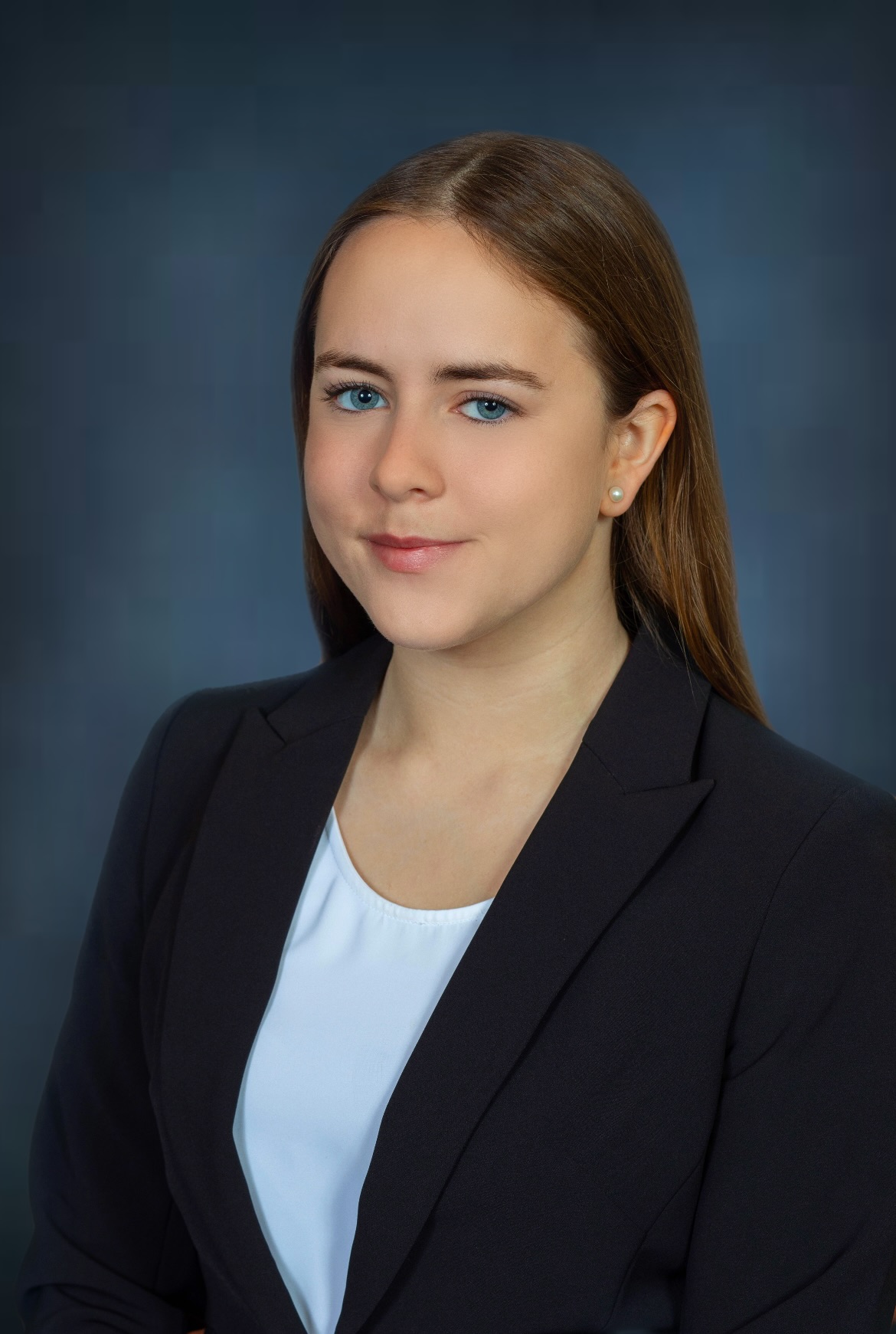
BIO
Hi! I'm Savannah Lebedeker, a second-year political science student pursuing a minor in environmental science and policy at Florida State University. I am involved in the Women Student Union as Political Education Coordinator and Women's History Month Coordinator, FSU PIRG as Vice President, and I am currently employed by the Mathematics Department as a Peer Learning Assistant. After undergrad, I hope to attend law school to pursue a career in environmental law.
Library in a Box
Authors: Savannah Lebedeker, Vashalice KaabaStudent Major: Political Science
Mentor: Vashalice Kaaba
Mentor's Department: Department of Information Studies Mentor's College: School of Information Co-Presenters: Cameron Glymph
Abstract
The "Library in a Box" initiative is a project specifically designed to tackle the digital divide, literacy gaps, and information inequities in underprivileged areas, notably in the Global South and rural regions of the Southern United States. By curating library resources and designing them to fit into a singular box to be sent to rural areas, the Library in a Box project gives communities the resources to develop their own easily accessible libraries. To form the prototype of the Library in a Box, our research team compiled literature reviews on the conventions and practices of ethical and sustainable mobile libraries, researched the best technology to be used in a mobile library setting, and crafted a survey to hone in on the specific interests and demographics of the areas where the project will be implemented. The preliminary results helped our team find the best ways to go about implementing the Library in a Box project based off of previous similar projects. The findings also helped us to find the technology to best suit our project. The survey results will be used to gain perspective on the communities that we pilot the Library in a Box project within the coming months. In the future, the project will be expanded to communities in Kenya and Uganda.
Keywords: Library, accessibility, literacy
24th annual Undergraduate Research Symposium, April 3, 2024
Ava Gonzalez Poster Session 5: 4:00 pm - 5:00 pm/323
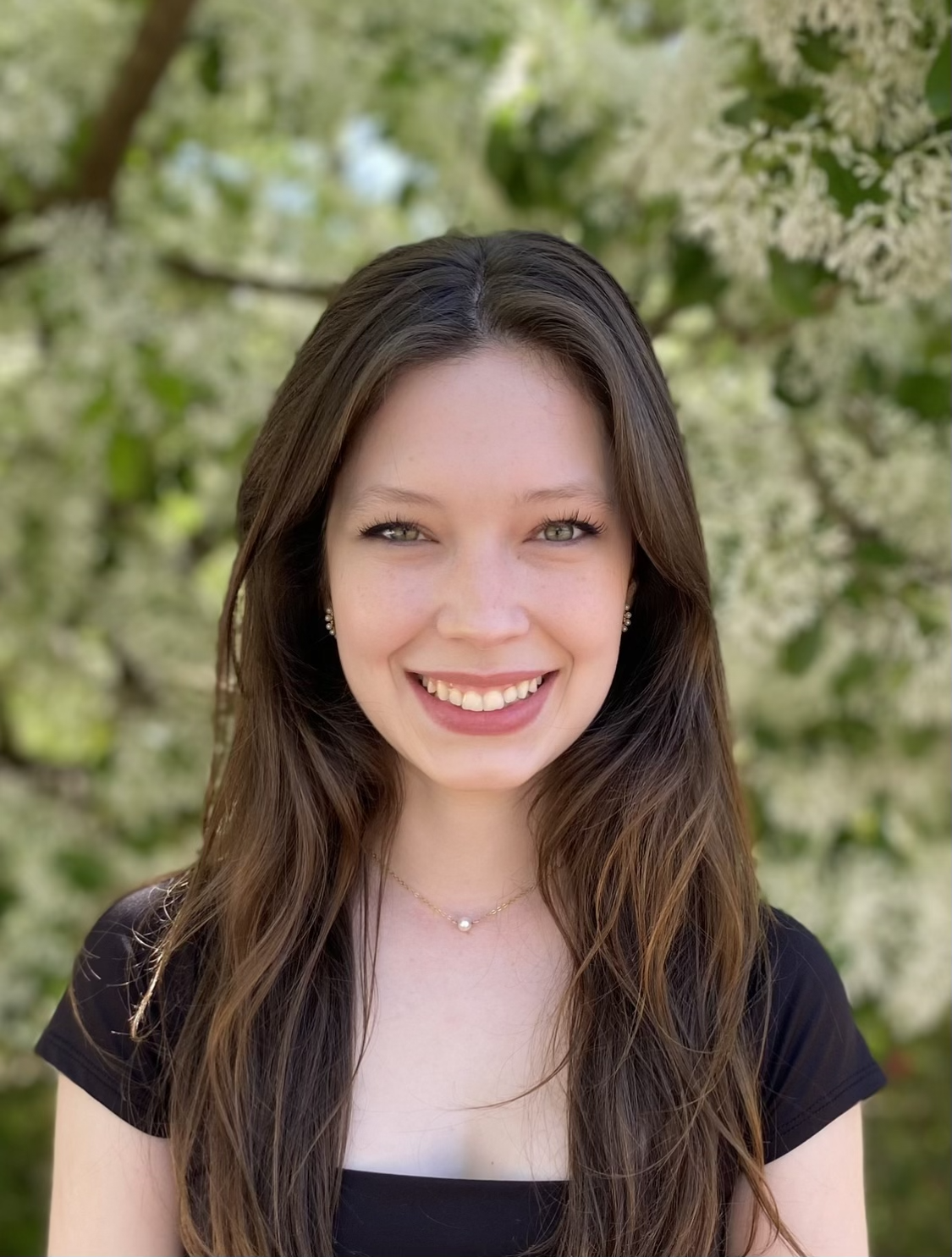
BIO
My name is Ava Gonzalez and I am a second year student at Florida State University majoring in psychology. I am interested in conducting research on detection and prevention of suicidal thoughts and behaviors. I plan on attending medical school and pursuing a career in psychiatry.
Self-Dehumanization and Entrapment as Predictors of Suicidal Ideation
Authors: Ava Gonzalez, Nikhila UdupaStudent Major: Psychology
Mentor: Nikhila Udupa
Mentor's Department: Psychology Mentor's College: Arts and Sciences Co-Presenters:
Abstract
According to the Three-Step Theory (3ST) of Suicide (Klonsky & May, 2015), the development of suicidal ideation is caused by a combination of pain and hopelessness. Subsequently, suicidal ideation can be mitigated by one’s level of connectedness, defined as a sense of purpose, when connectedness exceeds feelings of pain and hopelessness. The aim of this study is to expand upon existing research related to the 3ST and determine whether hopelessness, measured by entrapment, or impaired connectedness, measured by self-dehumanization, is a better predictor of suicidal ideation. A self-report questionnaire will be used to assess levels of entrapment, self-dehumanization, and suicidal ideation in undergraduate students at Florida State University. Data collection is ongoing; however, preliminary data suggests that together, entrapment and self-dehumanization predict a significant amount of variance in suicidal ideation. However, when accounting for entrapment, self-dehumanization is a non-significant predictor of suicidal ideation.
Keywords: suicidal ideation, entrapment, self-dehumanization
24th annual Undergraduate Research Symposium, April 3, 2024
Jibril Mustafa Poster Session 4: 2:45 pm - 3:45 pm /346
BIO
Hello, my name is Jibril Mustafa. I'm currently a sophomore majoring in Athletic Training from Tampa, Florida. I am currently working towards becoming a Physical Therapist and I decided to participate in Undergraduate research because I wanted to learn more about sports and health, fields that I am pursuing a career in.
Health, Culture, and Athletic Pursuits: A Critical Inquiry into Sport Anthropology
Authors: Jibril Mustafa, Dr. Amy KowalStudent Major: Athletic Training
Mentor: Dr. Amy Kowal
Mentor's Department: Department of Anthropology Mentor's College: College of Arts and Sciences Co-Presenters:
Abstract
Sports like basketball and soccer are prevalent throughout all parts of the globe, yet sports are not a common research topic in anthropology. Sport anthropology investigates how sport can shape societies in several ways, including socially, politically, culturally, and religiously. Sport anthropology also investigates how sport is shaped by these same aspects and many more. This study serves as a deeper analysis of how sport shapes and is shaped by health, specifically overall human health, cultural perspectives, nutrition, recovery, mental health, and rehabilitation. This project was a literature review and analysis of different sources relevant to the topics researched. These resources included articles, journals, and videos. The conducted search was done on academic databases and included keywords such as “sport health”, “nutrition”, “mental health”, and “athletes”, among others. The search almost exclusively yielded medical articles and journals. Many of these articles were difficult to understand as they contained medical jargon and concepts that were not easily digested. I found limiting and filtering the searches on the academic databases to be more successful. An example of this process includes limiting sources to only the last decade or also filtering sources to only include videos. This search of academic databases showed that there aren’t many different resources when it comes to sport anthropology and health. This calls for the advancement and growth of different types of sources and the inclusion of information that is easier to understand as well as engaging for readers.
Keywords: sport, health, anthropology
24th annual Undergraduate Research Symposium, April 3, 2024
Carlos Rodriguez Poster Session 2: 10:45 am - 11:45 am/344

BIO
Hello my name is Carlos Rodriguez and I am a current freshman at FSU originally from Miami, Florida. Coming into the program I didn't have many research interests and spent some time exploring the different projects. I was caught by this project when I saw it was associated with sports, but little did I know it would lead me into being interested in Agent Based Modeling. As a finance major, it has been amazing learning the ins and outs of what Agent Based Modeling entails, while even being able to think about how it could play into my future career in the business world.
Simulating Soccer Gameplay Using Agent-Based Models
Authors: Carlos Rodriguez, Mohammad NooranidoostStudent Major: Finance
Mentor: Mohammad Nooranidoost
Mentor's Department: Mathematics Mentor's College: Mathematics Co-Presenters:
Abstract
Soccer is the most global sport in the world and the reason for that may be due to its unpredictability leading to exciting matches. Many would say it is near impossible to predict matches perfectly.
This study focuses on exactly that. We began by creating a software to simulate soccer matches with sliders to affect how different players perform and interact with each other. We studied the performance of players in Serie A (Italian first division) teams and transfer their real-life skills and abilities into the simulation software. Traits such as how selfish players are with the ball, how far away from the goal they usually shoot from, and who they tend to pass to more often were come of the ones taken into account. We would run multiple simulations of the same match fixture in order to achieve a consistent result.
Testing involved creating the code for the simulation software as well as researching players attributes in real time games then computing these traits in the simulation.
Keywords: Agent Based Modeling, Soccer
24th annual Undergraduate Research Symposium, April 3, 2024
Fernando Carrillo Poster Session 1: 9:30 am - 10:30 am /409
BIO
Hello, my name is Fernando Carrillo. I am a senior in Biomedical Engeering from Miami, Florida. My primary interest in research is developing therapeutics for diseases that are considered untreatable by modern medicine. In this case, it is attempting to create a treatment that can work to help patients to recover form ischemic strokes. I hope to one day serve my community as an orthopedic surgeon.
Determining the Efficacy of Adipose Stem Cell Derived Extracellular Vesicles As Preemptive Treatments for Ischemic Stroke
Authors: Fernando Carrillo, Dr. Yan LiStudent Major: Biomedical Engineering
Mentor: Dr. Yan Li
Mentor's Department: Chemical and Biomedical Engineering Mentor's College: FAMU-FSU College of Engineering Co-Presenters:
Abstract
Stroke is a disease that many do not survive, and of those who do, many suffer lifelong impairments with suffering quality of life. It is a disease that can strike without warning and can take as little as minutes to cause irreparable damage to the central nervous system. As of now, the only preventative and preemptive treatments for stroke consist of a variety of prescription medications that come with several potentially detrimental side effects. Adipose stem cell-derived extracellular vesicles (ASC-dEVs) are being looked to as an alternative because they retain the ASCs regulatory functions without the risks associated with ASC stem cell therapy. Due to their relatively large size, ASCs have the potential to cause a stroke by creating blockages in blood vessels; on the other hand, their EVs are significantly smaller effectively negating this risk. Additionally, EVs cannot self-replicate, and as such, cannot become cancerous. In order to study ASC-dEVs as potential candidates for preventative care, they will be loaded into collagen hydrogels at varying doses. Following this, ASCs will be seeded on the surface of the gel and allowed to adhere to it before being placed in a hypoxic chamber for varying lengths of time for stroke modelling. The EVs will be characterized using ELISA assays, and cell viability assays will be run to determine the effectiveness of the treatment following a brief recovery period post-stroke modelling. The hope of this research is to provide a viable alternative to prescription medication for those with elevated risk of stroke.
Keywords: EVs, Stem Cells, Therapeutics, Stroke
24th annual Undergraduate Research Symposium, April 3, 2024
Ibukunolu Shofolu Poster Session 2: 10:45 am - 11:45 am/158
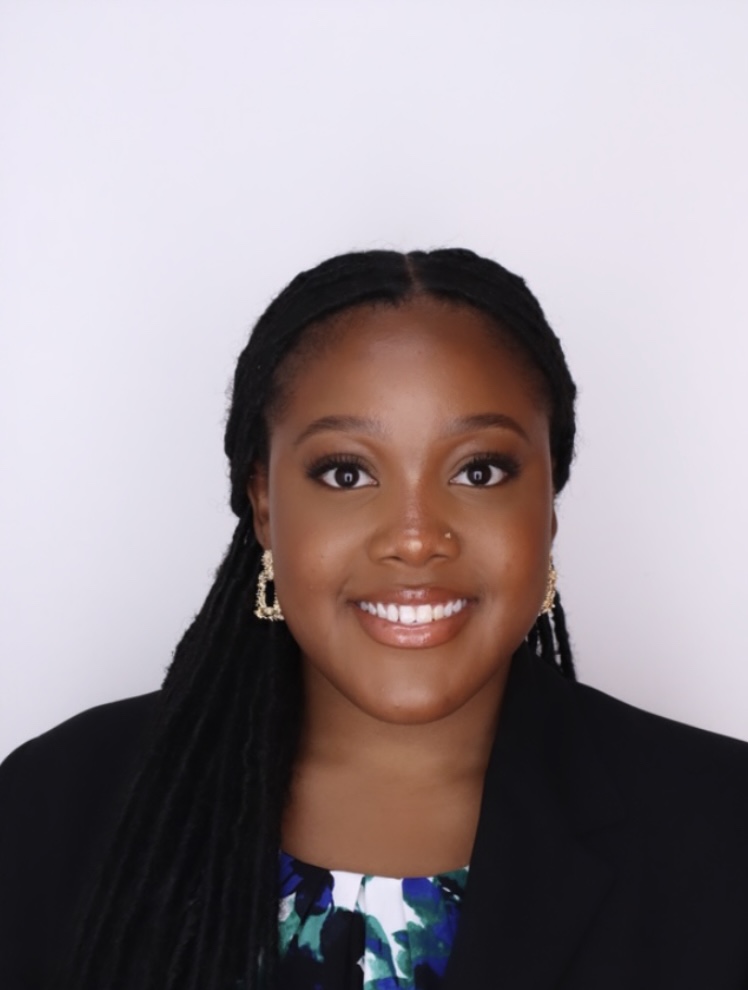
BIO
Hello!
My name is Ibukunolu Shofolu, I am a junior here at Florida State University. I am Nigerian but grew up in the city of Jacksonville, Florida. I am a biochemistry major on the pre-med track hoping to someday become an OB-GYN and primarily serve minority women in underrepresented communities in an effort to bridge healthcare disparities.
Investigating the stability of the TEMPO radical in the presence of phenol molecules
Authors: Ibukunolu Shofolu, Dr. Tomas OrlandoStudent Major: Biochemistry
Mentor: Dr. Tomas Orlando
Mentor's Department: EMR Mentor's College: National High Field Magnetic Laboratory Co-Presenters:
Abstract
Hyperpolarization is a method used to transfer energy from one molecule (the hyperpolarization agent) to another molecule (target molecule), This energy transfer sets the target molecules in a hyperpolarized state that is easier to detect with conventional NMR instruments. At this point, it is not clear which target molecule with an -OH group would be optimally bound by the nanoparticles without destroying the hyperpolarization agent attached on their surface: my task is to find out the optimal formulation of these systems (solvent, concentrations, type of target molecule) that allows for these experiments to be performed.
Molecules with -OH groups are usually quite reactive and they can easily destroy the hyperpolarization agents, which is an organic radical. Therefore, it is important to find a target molecule which carries an -OH group that doesn’t react with the hyperpolarization agent. To perform this experiment, I selected phenol (C6H5OH) as a target molecule and I used the organic radical TEMPO. The stability of TEMPO in the presence of phenol was tested with a systematic procedure. Continuous wave electron paramagnetic resonance (CW EPR) was performed at intervals of a few hours over four days to monitor the amount of radical present in the solution. An analysis of the data showed that the samples were stable, however as the time increased, the level of stability also changed. This experiment affirmed the importance of having a stable radical in the presence of a molecule with an OH group.
Keywords: Hyperpolarization, Electron Paramagnetic Resonance, TEMPO


